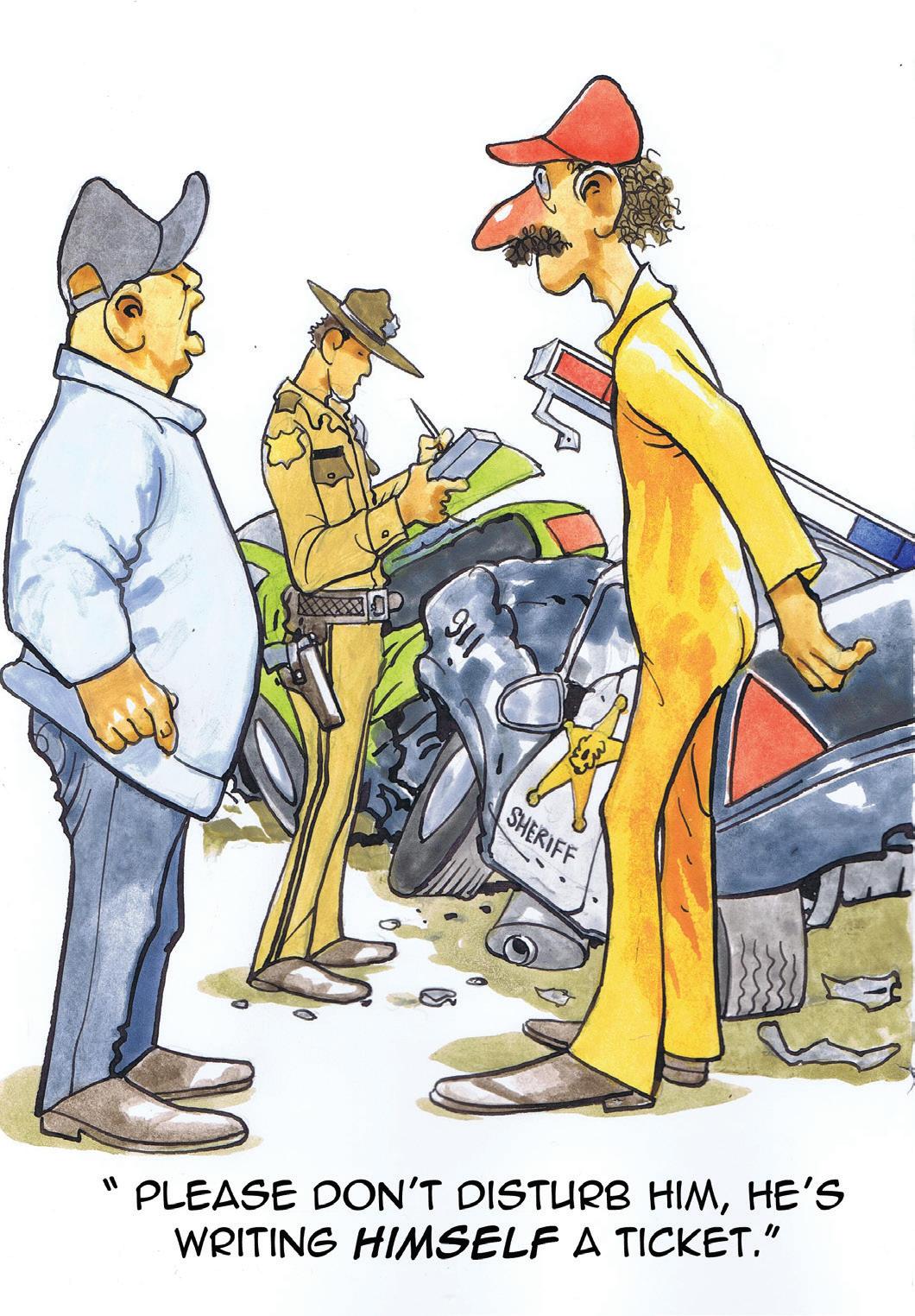

























Dennie Ortiz Publisher
As integral as towing and recovery operations are to the roadway systems functioning properly for travel and commerce, one would think this industry would have a more significant seat at the table when constructing state and federal legislation that impacts us directly, and thereby the motoring public.
While the towing industry has made great legislative strides, there is still a long road ahead to ensure that our
concerns and needs are more readily considered and met. To ensure that this goal is reached, an “all hands-on deck” approach can only be a winning strategy. The more voices spoken in unison, the greater the likelihood they will be heard.
Fortunately, there are individuals and organizations, alongside industry suppliers, which continue to push forward the industry’s agenda. Though, as these folks will tell you, more needs to be done, and more bodies need to join this force for action.
Brian Riker, in his role as Legislative Director for the PA Towing Association, and Chair of Towing Recovery Association of America’s Legislative Advocacy Network and Lobbyist member, is one of these “can do” individuals. In his article, Brian guides you through the latest annual gathering of towers taking their concerns to legislators in our nation’s capital. He reports on the current issues facing the towing industry that were addressed during this latest advocacy effort. Brian concludes by encouraging other towers to become more involved in their state and national associations to make a positive difference for their own businesses and even the industry as a whole.
Witnessing what towing professionals can accomplish on a bigger stage, we spoke with several towers from across the country to share their endeavors in support of their local communities. Contributing editor, Stephanie Marchese, recounts these special actions of towers, from renting motel rooms for stranded motorists, to providing “go bags” for victims of domestic violence, and championing the rights of children with special needs. This uplifting article reminds us all how a little help can go a long way in making a difference in people’s lives.
I chose to highlight these two pieces that showcase the strengths and accomplishments of so many towmen working above and beyond their 24/7 job to ensure a better world for the rest of us.
My hats off to all of you and as always, stay safe out there!

Steve Temple Editor
While we are encouraging regular winch maintenance and enhancing on-scene visibility in a couple articles for this month’s issue, let me add one more friendly reminder.
Oil analysis doesn’t often readily come to mind as an item to include in tow truck checkups, but it can serve as an invaluable early-warning system for preventing mechanical failures. Oil analysis is a precise way to assess the condition of the oil in an engine, as well as detect contamination within the engine that could create premature wear and result in
costly vehicle downtime. For example, the wear metals section of an analysis may detect a mechanical problem that has nothing to do with the oil. High levels of various metals could point to wear in the cylinder liner and/or other areas.
In addition, a regular oil analysis program provides a historical database, indicating trends in engine operations. Ideally, have a sample of used oil analyzed after every oil change for each tow truck. Although engine oil analysis is most common, it’s also beneficial to have gear oil, transmission fluid, and other vital lubricants tested.
An analysis program can also help determine the ideal timing for oil changes, and align them with other maintenance schedules, further minimizing truck downtime. Companies such as Shell LubeAnalyst and others can help optimize oil change intervals, so tow truck operators get maximum protection of their engines—and their livelihood.
Copyright ©2025 American Towman Magazine is published 12 times a year by American Towman Media, Inc.
Subscription: Single Copy: $10 1 yr: $60 – 2 yrs: $110 International: $75 & $140 itowman.com americantowman.com
of a competitors product or service.


SDMO laws have been expanded across the U.S. Initially designed to protect emergency personnel, these laws now include tow trucks, road service, and utility vehicles. Advocates, including the OwnerOperator Independent Drivers Association, have pushed for broadening these protections to cover all highway users.
This year, several states are revising their move-over rules to cover a wider range of vehicles. In Arizona, lawmakers are considering a study to evaluate the effectiveness of the current law, which applies to emergency vehicles, tow trucks, and maintenance vehicles. Similarly, California’s Assembly Bill 390 would expand protections to any vehicle with flashing lights or warning devices, while Kansas’ Senate Bill 8 proposes coverage for any vehicle displaying hazard lights or warning signals.
In New Jersey, a bill advancing in the statehouse would extend protection to all stationary vehicles with flashing lights or warning devices. Ohio and Oklahoma are also pursuing legislation to expand coverage, with penalties for violations increasing in some states. Meanwhile, West Virginia is considering adding maintenance vehicles to the list of protected vehicles.
Source: landline.media
A bill is being proposed to overhaul Connecticut’s towing laws.The bill proposes extending the current 15-day period for selling vehicles valued under $1,500 to 30 days, aligning Connecticut’s laws with other states that offer longer windows. Other key provisions include ensuring towing companies accept multiple forms of payment, offering extended access to vehicles over weekends, and implementing clearer documentation and a Consumer Bill of Rights for vehicle owners.
The bill also addresses issues with “trespass towing” by requiring property managers to cover towing costs if the DMV determines the tow was illegal. Industry stakeholders, including Timothy Vibert from the Towing & Recovery Professionals of Connecticut, have raised concerns over some provisions but agree that reform is necessary.
Source: ctmirror.org
On March 4, Karrington Anderson, Associate Policy Director for the Maryland Association of Counties (MACo), testified against Senate Bill 883, which would grant private towing companies the right to place a statutory possessory lien on vehicles towed from private parking lots. The bill would allow towing companies to retain vehicles until all charges are paid, something not allowed under current law.
Anderson argued that the bill raises serious constitutional and policy concerns, especially for consumers. “This bill would make it even harder for vehicle owners, particularly those with limited financial means, to reclaim their vehicles,” she said. “Without access to their cars, people may face challenges in accessing employment and healthcare.”
Proponents of the bill argue that it would help towing companies recover unpaid fees more effectively. Despite opposition, the bill remains under debate, with supporters pushing for reforms they believe would provide

necessary protections for businesses in the industry.
Source: conduitstreet.mdcounties.org
The Idaho Transportation Department (ITD) has introduced a new roadside patrol to assist motorists along the I-90 corridor. The service will operate Tuesday through Friday, from 6 a.m. to 4:30 p.m., offering quick help to drivers in need.
I-90 is a critical link between Idaho and Spokane, Washington, and is known for traffic congestion. The highway sees an average of 4,100 trucks daily, especially from the Idaho-Washington border to Coeur d’Alene. ITD’s new response truck will patrol this area, focusing on high-traffic zones, construction sites, and areas prone to accidents due to limited shoulders.

The IDT response truck will patrol the congested Interstate 90.
repairs like flat tires, dead batteries, and running out of fuel, allowing vehicles to move off the road safely. It will also provide traffic control during emergencies, reducing risks for other drivers.
The truck will aid with minor
Source: ttnews.com
North Carolina lawmakers have introduced a bill aimed at addressing predatory towing practices in the state. House Bill 199, known as the “Nonconsensual Booting and Towing Reform,” was filed in the General Assembly. The bill seeks to create a nine-member commission to regulate towing companies, set maximum fees for towing, booting, and storage, and require companies to obtain permits.

The legislation would also introduce several consumer protection measures. It mandates that private property owners display clear signage at least 24 hours before towing a vehicle, limits the distance a towed vehicle can be transported to 25 miles, and requires towing companies to accept multiple payment methods, including cash and cards. A statewide database would be created for reporting each tow, allowing vehicle owners to track their cars by make, model, and license plate.
Rep. Laura Budd, who filed the bill, emphasized the need for accountability
in the towing industry, citing the rising costs of reclaiming towed vehicles. “At first, it was $300, then $500, then $750, and now $1,000. Where does it end if we don’t have regulations?” she said. The bill would also impose penalties for violations, including fines and possible criminal charges for repeat offenders. If passed, the commission would be established in January 2026, and most provisions would take effect by July 2026.
Source: wcnc.com
New legislation in Illinois seeks to rein in towing companies that exploit drivers in the aftermath of accidents. The “Rogue Towing Regulations” bill aims to strengthen enforcement against unlicensed and illegal towing operations. In May 2022, ABC7 accompanied Chicago’s Business Affairs and Consumer Protection Department and local police as they identified towing violators who lacked proper licenses and were using illegal scanners and lights.
State Representative Will Davis expressed concern over towing companies that use scanners to monitor accident scenes, targeting vulnerable drivers who may be in shock or require medical attention. Under current law, tow companies are prohibited from arriving unless called to the scene.

The new bill would provide the Illinois Commerce Commission (ICC) with more power to impound trucks with unpaid fines, revoke truck plates, and tie towing licenses to individual owners, preventing bad actors from simply changing company names to continue operating illegally.
Fling’s Towing, a family-owned business in Coatesville, Pennsylvania, was recognized as the 2025 Small Business of the Year by the Western Chester County Chamber of Commerce. Celebrating 40 years in operation, the company has built a reputation not just for towing excellence but for its commitment to the local community.
Founded by Daryl Fling in 1985, the company has grown from a two-truck operation to a fleet of 22, employing 20. Despite its growth, the business maintains a strong family atmosphere.
“As we grew and brought on more employees, we kept that same familystyle feel,” said Fling. Beyond towing, Fling’s Towing regularly participates in local events, supports nonprofits, and delights children with their fleet at Touch-A-Truck events.
“They sure do love it when I show up,” Fling said, emphasizing the importance of reliability and helping to cement its place as a trusted name in its community.
Source: vista.today
Prosecutors charged Christopher Sponholz in the Christmas Eve hitand-run that killed tow truck driver Hussain Farhat on I-94 near Delafield, Waukesha County in Wisconsin. Farhat was helping a stranded driver.
A criminal complaint states Sponholz, 39, told friends he thought he hit a deer. Witnesses said he was driving 80 mph when he failed to move over and struck the tow truck.
Court Commissioner Daniel Rieck called his actions reckless. Sponholz turned himself in on Christmas Day after family members saw news of the crash. An anonymous tip led investigators to his home, where his sister reportedly said, “Chris hit that guy last night, I know it.”
Prosecutors charged him with hitand-run causing death. His attorney requested a $7,500 bond, but the court set it at $750,000.
Source: msn.com

By Terry Abejuela
Winches have been around for centuries and have played an important role in many industries, especially in the towing and recovery industry. They have

Field Editor Terry Abejuela has 40-plus years of light-duty towing and recovery experience. He is also a light-duty Level 1 instructor for the California Tow Truck Association.
evolved from a simple hand-cranked version of years gone by, to the more complicated and powerful hydraulic units we use today. Whatever the type, the basic function is the same: a drum or spool is rotated either by hand cranking, or with a motor or other power source, to reel in or out a cable or rope to efficiently move a load.
Most winches on tow trucks were selected by the towing equipment manufacturer based on the intended use and capacity required. When replacing a winch on a tow truck, it’s recommended that the replacement winch match the towing equipment manufacturers specifications. Seek the advice and


assistance of a qualified person for information before operating, purchasing, installing, maintaining, or inspecting a winch. Familiarize yourself with all manufacturer instructions and warnings prior to operating any winch.
This article won’t go into the complexities of winch designs, and the different types of gears, gear boxes, or gear ratios. Instead it will focus on general inspection, maintenance and safe operation.
The two most common winch designs used in our industry are the “worm gear" and “planetary gear design.” The worm gear consists of a gear arrangement where a worm wheel meshes with a worm screw. A planetary gear consists of one or more ring gears, sun gears, and planetary gears in a carriage.
Always read and follow the winch manufacturer recommendations for inspection and maintenance. A quick visual inspection should be conducted prior to each use to ensure there is no visible damage, loose, or missing parts. Most winch manufacturers recommend a weekly, monthly, and thorough annual inspection.
The weekly inspection should include:
• Check the oil fluid level. Most winches will have a fill plug that can be opened and the oil level should reach the bottom of the threads. This can be done less frequently depending on the use and environment.


and/or damage to the clutch gear. Lubricate zerk fittings as needed.
pg. 7
Winch pg. 31 Sepson pg. 47 Winches Inc. pg. MW74
• Ensure that the wire rope is properly wound on the drum and re-wrap if necessary. The rope should be wrapped tight with no gaps in any layers.
• Check the pressure relief plug. This plug allows gasses from the hot oil to escape.
The monthly inspections should include:
• Operate the free spool control several times to ensure that it engages and disengages properly. Lubricate the zerk fittings if needed. Some winches may be ◀
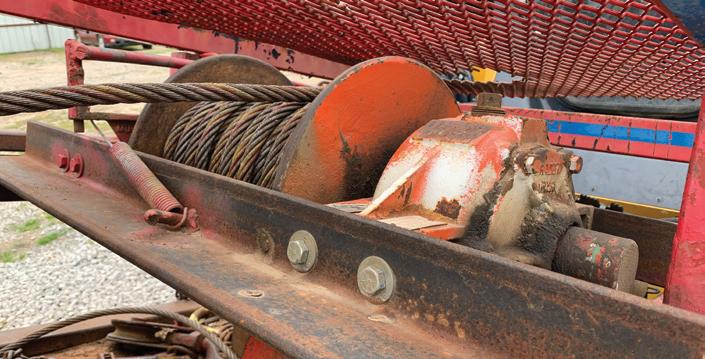
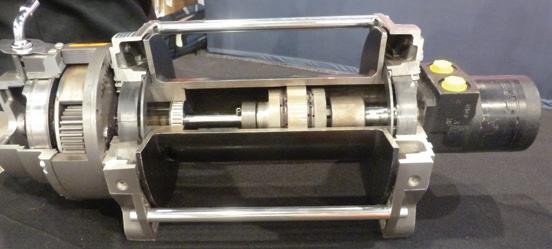

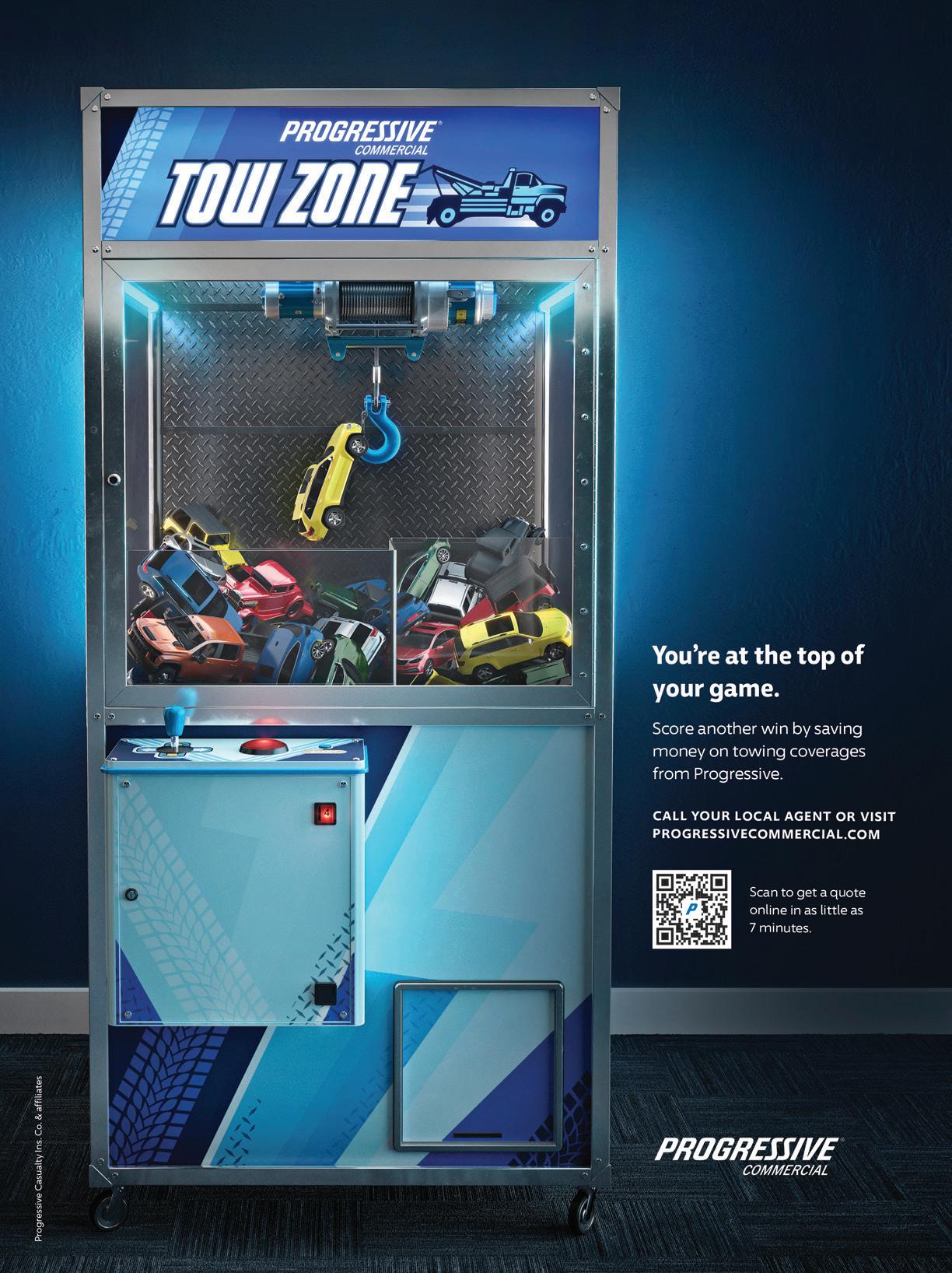

equipped with an inspection hole allowing a visual inspection of the free spool sliding clutch. This is sometimes difficult to find because it may have been painted over.
• Inspect the winch mounting bolts. Make sure that none are missing or damaged and are all tight. Most manufacturers recommend Grade 5 bolts or better.
• Visually inspect the winch frame and surrounding structure for any signs of deformation. The annual inspection should include:
• All items from weekly and monthly inspections.
• Change the oil. This may need to be done more frequently depending on use and environment. Some manufacturers recommend draining the old oil, filling the reservoir with kerosene, and operating the winch under no load on the reel for a few minutes. Then drain the kerosene and refill with the manufacturerrecommended oil.
Be sure to estimate the load being placed on the winch, confirming that it is within the working load limit of the winch. The maximum rating for the winch is based on the first
layer of the rope on the drum, with a minimum of five wraps maintained on the drum. The winch rating will decrease as more layers are spooled onto the drum. An 8,000-pound rated winch is only rated at 6,700 pounds on the second layer, and 5,700 pounds on the third layer. The attachment point for the rope-to-the-drum is not intended to support any portion of the load. As stated previously. maintain at least five wraps of rope on the drum to support the load.
When operating the free-spool on the winch, make sure before placing a load on the winch that it is properly engaged. If the winch is not properly engaged, it may free-spool under a load and release it. Lock the free-spool control and winch-in until the operator hears and sees the free-spool control engage. Winch-


The Sepson H35K and H12K Sepdurance winches are both military-grade units. The H35K has a grooved drum for faster and safer cable retraction, and the H12K is a compact design for fitting side-by-side, along with several other features.
out momentarily, and then winchin and place the load on the winch. Improper engagement of the drum may also cause damage that may allow the winch to free-spool even if operated properly.
Following are several items that should NOT be performed:
• Do NOT disengage the clutch when the winch rope is under a load.
• Do NOT rely on the winch to support a raised load. Use a jack stand or wheel block to support the load if it’s needed to get under it.
• Do NOT use the winch to lift or move people.
• Do NOT use the winch to secure a load in place. When securing a vehicles on a car carrier, the winch, rope and loading bridle should NOT be considered a tie-down. The winch on the car carrier is intended to load and unload vehicles, NOT as a securement device.
• Do NOT become distracted. Focus on the winching operation whenever reeling in. Maintain an unobstructed view of the winching operation.
If an operator has to take focus off the winching operation, stop winching. Keep all spectators and first responders a safe distance from a winching operation.
Always wear the appropriate personal protective equipment when operating the winch, including gloves, safety glasses, safety-toe work boots, and high visibility apparel.
It is imperative that tow truck operators know how to inspect, maintain and safely operate the winch on their towing and recovery equipment before attempting to perform winching operations. Everyone’s safety is at stake when operating a winch.
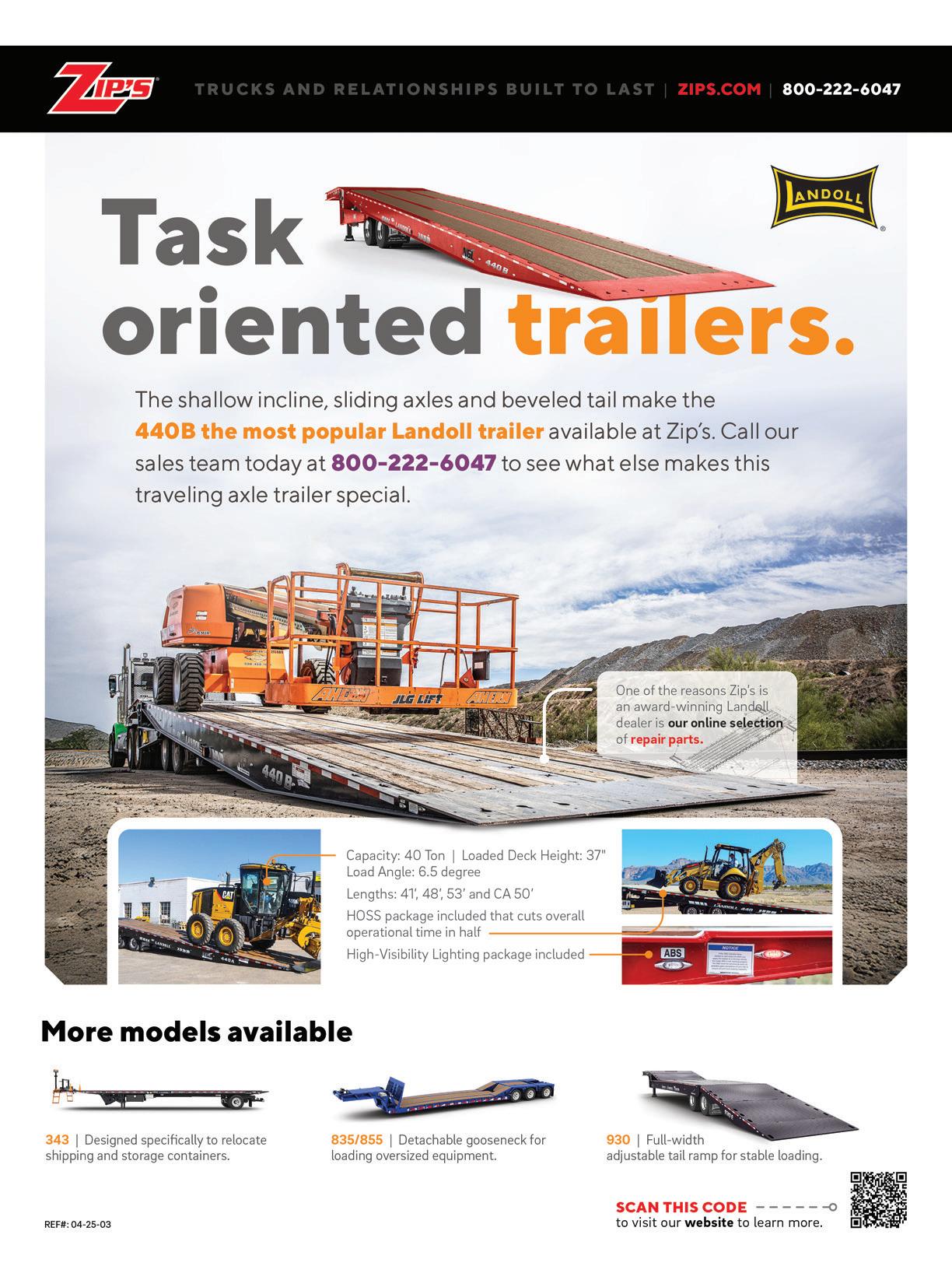

A remote-controlled spotlight, such as this Stryker ST Series by Golight, can greatly enhance a towman’s roadside visibility by illuminating multiple positions around the vehicle with just a touch of a button.
By Randall C. Resch

Operations Editor Randall C. Resch is a retired California police officer and veteran tow business owner, manager, consultant and trainer. He writes for TowIndustryWeek.com and American Towman, is a member of the International Towing & Recovery Hall of Fame and recipient of the Dave Jones Leadership Award. Email Randy at rreschran@gmail.com.
While it’s true motorists can get distracted and unintentionally drift onto a highway’s shoulder, a staggering percentage of tow operators lose their lives while working traffic-side incidents, often without any visual warning for approaching traffic. As noted in fatality investigations, numerous experts point to an obvious root cause: “Towers, for whatever reasons, choose not to include advanced warning as a solid safety practice.” Tow operators often fail to deploy cones, flares, triangles, or signage to shoulder-side events. Many towers will admit, “We don’t use em’ at all!” Excuses for not using these warning signs include:
• “They take too long to set up”
• “Setup takes longer than I’m on-scene”
• “I don’t know how to light flares”
• “We don’t carry ‘em”
• “I don’t like flares because they fall apart”
• “Flares are expensive”
• “They might ignite in the boxes”
• “They’re a pain to stow on the truck”
As just one example, a California tower “tempted fate” while working a tire change on a narrow shoulder of a busy highway, on a curve, at night, and in light rain, with the tow truck not displaying emergency lighting. The tow operator wasn’t wearing a vest, and had the motorist hold an umbrella as he knelt to handle a white-line tire change. A vehicle came within inches of hitting them. This incident serves as an object lesson for employing some kind of advanced warning at every roadside recovery.
For tow operators working state highways, contract requirements often dictate that responding towers attend a national Traffic Incident Management (TIM) course. (Note, however, that not all states require towers to enroll in TIM classes.)
Along with formal tow operator safety programs, TIM provides necessary safety guidelines for first responders and tow operators. As emphasized in TIM programs, there’s value in providing advanced warning to motorists. Especially true to nighttime environments and weather extremes, adding cones, flares, triangles, and emergency lighting are key components that provide an enhanced level of safety to on-highway incidents.
Emergency lighting is essential for getting motorists to follow SDMO (Slow Down, Move Over) laws (see sidebar on Lighting for Higher Visibility Night Operations). If a wayward motorist steers into a well-lit work environment, at the very least there’s some degree of accountability against the motorist.
In addition to nighttime operations, the type of road can be a factor as well. Most highway shoulders are typically 12 feet wide, and the footprint of a tow truck is typically eight-feet wide. In rural settings, though, shoulders are often much narrower. Also, larger wreckers


and carriers are often wider than the shoulders. Worse yet, where tall sound-barrier walls are present in congested cities, cab carriers barely fit. This poses yet another a scary scenario for a roadside recovery.
Before handling any roadside response, towers should have full understanding of Federal Regulation CFR 392.22, regarding “Hazard warning signal flashers.” It states, in part, that, “Whenever a commercial motor vehicle is stopped upon the traveled portion of a highway or the shoulder of a highway for any cause other than necessary traffic stops, the driver of the stopped commercial motor vehicle shall immediately activate the vehicular hazard warning signal flashers and continue the flashing until the driver places the warning devices required by paragraph (b) of this section.
Based on the 700-plus U.S. tow operators killed nationwide while working shoulder events, it seems obvious that advanced emergency warning is an essential aspect of roadside recoveries. When operators are killed by on-highway strikes, investigations often reveal associated factors leading to fatalities, and define actions that the towers could have implemented for better on-scene safety. The following recommendations are examples from OSHA, CDC, NIOSH and highway patrol investigations pertinent to advanced warning:
• “Kentucky should create a law requiring the use of portable emergency warning devices when an emergency vehicle is stopped at the side of the road.”
• “Laws in other states, such as Maryland and Washington, require that whenever a vehicle is disabled on the roadway or shoulder of any highway, the driver of the vehicle shall immediately display a portable warning device. Making this mandatory may increase the likelihood that people will exercise more caution by using the warning devices in the future when working around a disabled commercial motor vehicle.”
• Employers and tow truck operators should ensure the use of warning devices to alert approaching motorists whenever a worker is located outside of the tow truck.”
• “…mandatory pre-trip inspections could help ensure the drivers are fully equipped with all of the emergency warning devices that would be necessary in the event that the truck became disabled. The devices should be used every time anyone is working outside the vehicle along a road or a highway. The device should be displayed throughout the entire time the vehicle is so disabled.”
• “…to the practice of initiating ‘advanced emergency warning,’ towers are reminded to utilize overhead emergency lighting
and/ or four-way flashers in accordance to with their state’s, Slow-Down Move-Over laws.”
• “The use of emergency lighting is a prime means to alert approaching motorists of a tow truck’s presence ‘parked’ on the highway’s shoulder or center median. While the highway patrol is quick to criticize the use of tow trucks and emergency lighting, a level of on-scene safety is recognized.”
A lighted, phosphorous flare is usually visible from three miles away and its “white-hot (red) burn” pierces through bad weather conditions and darkness. Flares send an obvious message indicating some sort of hazard is ahead, such as on a blind curve or blocked lanes, along with snow, rain and foggy environments. Although flares add a significant roadside presence, they are not recommended in areas of wildfire risk or fluid-spill environments for obvious reasons. Never place flares near vehicles, tow equipment, or locations that may ignite. Once an incident is cleaned up, operators must extinguish smoldering flares to avoid burning remnants being disbursed into roadside brush. Use extreme caution when extinguishing them, as smoldering or spitting flares can cause splatter burns to lower legs and feet.
Traffic warning devices, when placed properly, create a recognizable path for approaching motorists. It is recommended that flares are situated with the first one about 20 feet behind the tow truck, then in approximately 40-foot increments “tapered” from traffic side lane markings toward the shoulder’s inner edge. Remember to put the igniter cap on the flare’s nonburning end to stop it from rolling. ◀

When darkness falls, additional safety issues arise for towers responding to calls. This is especially true for towers who respond in a reckless manner, as they create danger to themselves and the motoring public. Most state vehicle codes don’t allow tow trucks to drive in traffic with emergency lights activated. While some states require it when the tow truck is loaded, the lights should be off if it’s not required.
The towing equipment industry is chockfull of products designed to increase tow truck safety. Not only are American Towman shows an excellent source of safety-related products, but essential merchandise can also be found at a number of trusted suppliers. With the simple addition of reflective tape, a truck’s rear tailboard will visually “pop” so there’s no mistaking its presence. What about lights, though? Many wreckers and carriers are over-illuminated in accent areas including the underbody, inner grille, and wheel-wells. Always consider that too many lights can add to a motorist’s confusion, especially at multi-unit rescues and chaotic collisions.
As stated previously, some state laws allow that in certain conditions, such as under load, when the tow truck is moving or towing at speeds slower than traffic flow, an obstacle blocks lanes, or an unusual traffic situation exists, the tow truck may operate with overhead lights illuminated.
All states have SDMO Laws specific to tow trucks as an additional measure of defense, requiring motorists to slow down and move over. When in the active process of tow, transport, service, and recovery (unless otherwise prohibited by state law), turn on the tow truck’s emergency lighting to enhance visual notice that roadside activities are in-process.
For roadways with a curving approach, devices should be placed farther up or down the roadway to provide more advanced warning. Placing devices at the tow truck’s location enhances the motorist’s visual attention to slow down and move over.
However, in an industry where “more is better,” towers should consider setting up emergency devices well beyond the visual range of activating emergency lights.
What might a towman expect in a courtroom setting after someone
While highway patrol agencies believe four-way flashers don’t create a distraction, that’s old-school thinking when gambling with a company’s liability. SDMO laws describe authorized use of overhead emergency lighting. Refer to individual State Vehicle Codes for further information.
Wearing ANSI-III reflective vests is just plain smart. Operators not wearing a vest and subsequently struck while working, leave their company open to liability issues with insurance examiners and Worker’s Comp who will question the company’s safety training. Company bylaws must clearly state that reflective vests are worn during all towing operations.
Common sense plays a big part in applying emergency lighting, along with direction from law enforcement. Tow trucks, roadside service vehicles, and car carriers engaged in towing, transport, and recovery, should be outfitted with professional-grade, emergency strobes or LED rotator lights, as well as the appropriate lens color dictated by their State’s vehicle code laws.
When tow trucks are on scene, SDMO typically requires trucks are parked and stationary. Lights may then be activated in strict accordance with vehicle code laws. The following procedures may be applicable:
• If allowed by law, activate emergency lighting when slowing, preparing to pull onto emergency shoulders, or when returning into traffic.
• SDMO laws authorize activation.
• If line-of-sight vision is obscured on a hazardous curve.
plows into a parked wrecker and a motorist is killed? When towers are asked, “Did you do anything to identify your active work zone?”, only two possible answers exist: “Something” or “Nothing.” Should the answer be the latter, the seed of incompetency has been planted and a costly settlement in favor of the plaintiff’s family is likely.
On a final note, according to the FWHA.dot.gov website, 67 percent of tow and recovery operators have already attended a National TIM course. Get trained for free online or in a live TIM class. Invest time to learn best practices that could affect
• If driving slower than the flow of traffic under loaded conditions.
• If requested by officer(s) on-scene.
• If other hazardous condition exists.
• When tow and recovery actions justify emergency lighting.
Not all states recognize tow trucks as first responders. If your state’s vehicle code laws don’t recognize tow trucks as first responders, don’t get caught in a trap of misunderstanding. On the other hand, when state laws indicate that tow trucks are first responders, owners and tow operators accept a higher level of responsibility. Many tow truck collisions involving fatalities were caused by tow trucks “expediting.” To drive in expedite mode, illegal behaviors lead operators to speed, cut motorists off, drive on sidewalks, make illegal turns on-the-highway, and even cause road rage events.
Don’t be lulled into a false sense of security. Never believe emergency lighting (of any kind) will be an ultimate form of protection for the operator. Always be aware of surroundings and approaching traffic, and recognize that safety lights are not a fail-safe measure.
In all situations, towers are allowed certain discretion as to whether or not they choose to activate emergency lighting. Whether working day or nighttime incidents, making one’s presence known is an operational and legal consideration. Effective tow truck lighting is not just a regulatory requirement, it’s a matter of life and death, but must always be used in accordance with the state vehicle code laws.
long-term survival. To maximize safety, towers should utilize every available resource to provide early warning, notifying drivers of a tow truck’s presence on the road. It just might save lives.
Editors Note:
You can attend a free TIM course at AT ShowPlace sponsored by Allstate Roadside on Thursday, April 24th at the South Point Convention Center, Las Vegas from 8:00am - 12:00pm. All attendees must be registered for the course.
To register go to: ATSHOWPLACE.COM


By Stephanie Marchese
The towing industry is built on grit, determination, and the ability to handle highpressure situations. Towers are the ones who show up in the dead of night, in the middle of a snowstorm, or on the side of a busy highway to pull people out of danger, or to simply get them home. The work is tough, unforgiving, and often thankless. But beneath the rough and rugged exterior of the industry lies a deep and abiding culture of generosity.

Stephanie Marchese is the newest member of the American Towman Editorial Staff and brings nearly a decade of publishing experience, most recently in the book publishing sector. In addition, Stephanie is the in-house proofreader and Assistant to the Publisher.
Towers are known for their calloused hands, steel-toed boots, and no-nonsense attitudes, but what many don’t see is the heart behind the hook. Across the country, towing companies both small and large, give back to their communities in ways that go far beyond pulling wrecked cars off the road. They feed the hungry, as evidenced by our own 2023 Silver Star recipient, Tommy Ferguson, who is known to have rented motel rooms or vehicles for stranded

motorists, without ever asking for reimbursement. Tommy has donated both his time and money to such charities as Make-A-Wish, Touch-A-Truck, and Autism Rides, and has gone so far as to bake hams and turkeys for the elderly or donate toys to needy families.
Towmen across the country support veterans, help families in need, and rally, often in the hundreds, around families who have lost loved ones.
One tow company has a unique way of giving back to their community by way of Domestic Violence (DV) bags. On Site Towing in Humble, TX spearheaded a campaign to make available a bag for people displaced by domestic violence incidents. Contents included such necessities as hotel vouchers, toothbrushes, and even free legal counsel, to name just a few items.
When asked how they came about such a distinctive contribution, On Site Towing president, Mark Denson, shared that they cover all light, medium, and heavy-duty contract work with the police, and encounter domestic violence cases quite regularly.
“We’re the ones who move the people around,” Mark revealed. “We might be their only means of escape.”
As explained by Harris County Precinct 1 Constable, Allen Rosen, “This partnership is a Godsend.” Constable Rosen added that, “We can call on our wrecker community to get people out of a bad situation, and they do it gratuitously, for free, and that’s putting your money where your mouth is.”
Sensing the need for provisions for people forced to run away while their abuser is not around, On Site jumped in to help, and teamed up with the police and ADVA (Aid to Victims of Domestic Abuse) to create the bags with much needed resources. Mark also advises that it was important to get political officials involved in order to collect donations. In this capacity, officials reach out to local business and stress the need for their donations of goods and services, which often has ◀



better results than one company just reaching out to another. The project, which started about three years ago, has captured the attention of other states around the nation who also want to get the program running in their communities.
On Site Towing is also responsible for raising funds by hiring out their specialty vehicles (note photo page 24) to birthday parties and corporate events, and using the proceeds to purchase bicycles for local police to distribute where they see fit. In 2024,

200 bikes were donated to the local police to give away.
Another heartwarming story of giving back came from Mike Horan, a WreckMaster-certified tow operator at Sterry Street Towing in Rhode Island and Massachusetts for the last decade. He stopped by American Towman Exposition’s subscription booth in Baltimore last November to share his passion with our editorial team. Mike was born into the towing business, and as a young boy, his father often took him on calls. Mike’s dad had the state of Rhode Island contract with the Dr. Joseph H. Ladd School (Ladd School), an institution for people with profound developmental disabilities.
As a child, Mike accepted it simply as a school, but as he grew older, he began to realize the school was in fact, more like an institution. Many of the residents didn’t actually belong there, and the treatment they received was often compared to something from a horror novel. In high school, when the practice of placing disabled students in general education classrooms, called “mainstreaming,” became more common, Mike felt compelled to involve himself with the specialneeds community. More recently, through his wife, Cyndie, who is the director of the medical support team with the Special Olympics, Mike has carried this passion into adulthood.
Specifically, along with the Sterry Street Towing crew, Mike participates in leading the convoy that kicks-off the Rhode Island chapter of the Special Olympics every September. Mike has brought community outreach to its current exceptional level at Sterry Street Towing and singlehandedly raised over $41,000 last year for the Special Olympics Rhode Island (SORI), and nearly $193,000 throughout his

years of fundraising. The once-modest SORI affair has mushroomed under Mike and Sterry Street to become a significant event, escorted by more than 25 police vehicles from one end of Rhode Island to the other, to begin the Special Olympics Summer Games Weekend. According to Mike, “Once you meet these athletes, you’re hooked.”
Always thinking more could be done, the crew at Sterry Street, Mike included, began participating in the annual “Plunge” every January 1 to raise additional funds for SORI, and eventually, the “Superplunge” which consists of each participant plunging into the freezing Atlantic Ocean every March, 24 times in 24 hours! Not to be forgotten is the commitment of Sterry Street and Mike Horan to raising funds to replace outdated medical equipment, and provide additional AED (Automated External Defibrillator) devices for the event each year. In addition, Special Olympics Rhode Island president, Ed Pacheco, procured a grant to transform an otherwise unremarkable old trailer into a graphic representation of Rhode Island’s commitment to the Special Olympics.
There is also Trucks for Tots which comes alive with flashing lights from tow trucks across the country every second Sunday in November. This annual parade is a rolling convoy of goodwill that delivers joy to children in need. The event’s dedicated director, Jim Bresnahan, organizes rigs of all sizes, decked out in Christmas cheer and carrying the same precious cargo: donations of toys, collected by towers who’ve traveled hundreds, sometimes thousands, of miles to be part of something bigger than themselves.
Also worth mentioning is American Towman’s own Towman of the Year 2023, Ron Myers, and his dedication to several outreach programs in Ohio. Each year, Ron’s company, Pine Tree Towing & Recovery, participates in the annual Christmas Parade for Nationwide Children’s Hospital. Working along with the entire Ohio towing community, this event has raised over $17,000, which is used exclusively

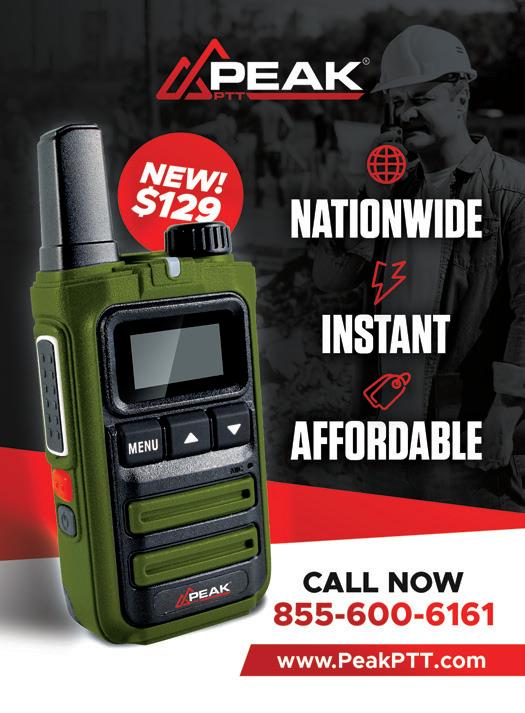

to assist families of children receiving treatment. Pine Tree Towing is also involved in several outreach programs, including sponsoring the local hospice Touch-A-Truck program, handing out gifts to kids in attendance, the local K9 programs with law enforcement, and the breakfast with the Grinch every December. Ron proudly admits to also sponsoring several local youth sports teams and providing equipment such as helmets and uniforms for several schools in the area.
Perhaps one of the most meaningful ways towers give back is by honoring their own. The towing industry is dangerous, and every year too many operators are killed while working the white line. To ensure they are never forgotten, towing companies across the country organize memorials, candlelight vigils, and “Slow Down, Move Over” awareness events.

While it would be impossible to name them all, the spirit of giving stands out as a defining trait of the towing profession.
For many towers, giving back isn’t about publicity or recognition—it’s just a part of who they are. They see people at their worst: stranded on the highway, shaken after an accident, or struggling to figure out how they’ll afford to get their car out of impound. Towers know that sometimes, a small act of kindness, such as a waived fee, a ride home, or a warm cup of coffee, can make all the difference. The men and women behind the wheel of a tow truck might look tough on the outside, but they have some of the biggest hearts in the world.
American Towman is always looking to recognize the heroes of the towing industry. Whether through the prestigious ACE Awards, or on our magazine cover as the annual Towman of the Year, or perhaps in Baltimore as a Hero or a Silver Star, or even as a Master of Chaos at a tribute during our Texas TowXpo, we honor those who go above and beyond.
If you have a story of bravery, dedication, or exceptional service, we want to hear it! Contact Stephanie@ towman.com with your submission.

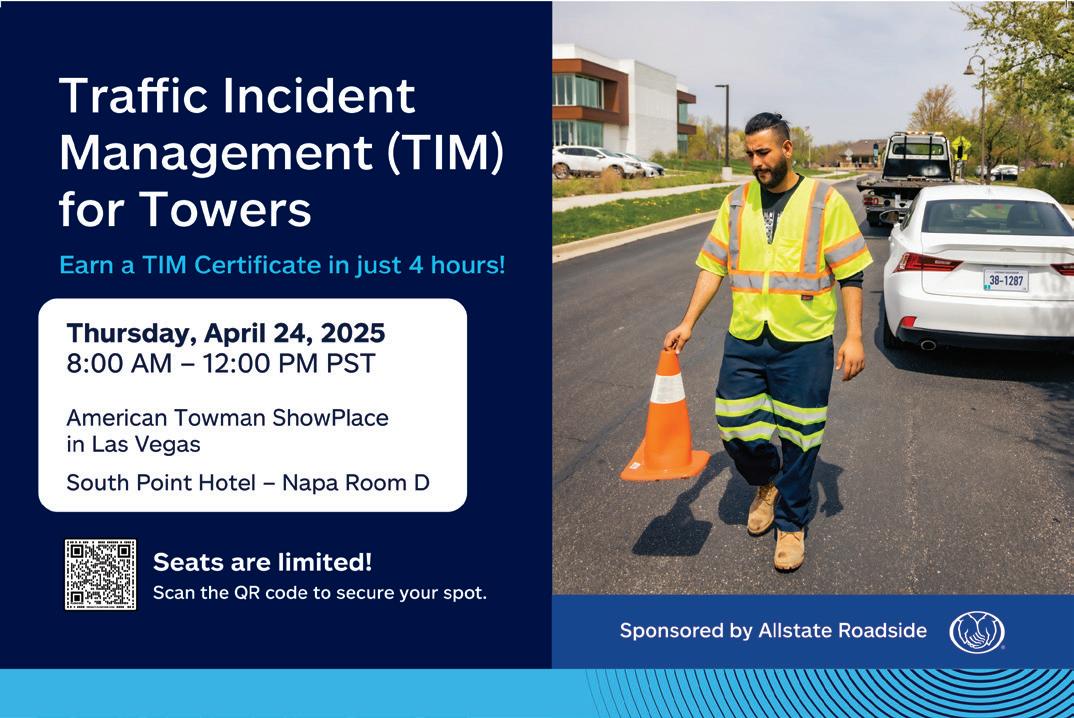
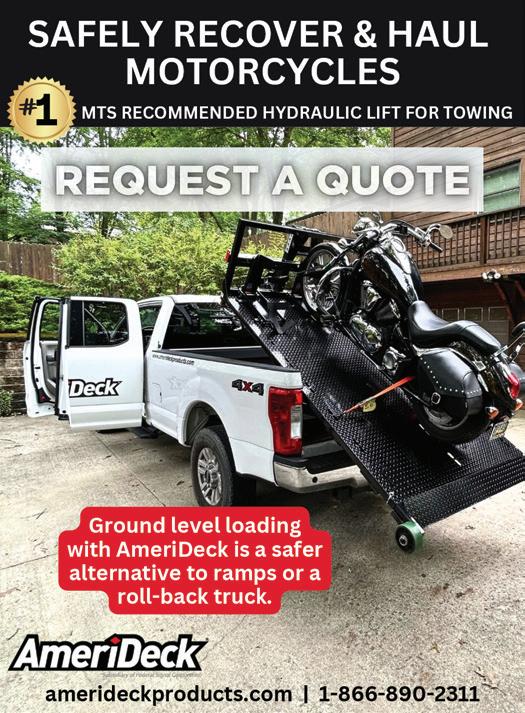

Danco Products, a manufacturer of towing and hauling equipment, has recently announced that it remains a family-owned business after celebrating 52 years in the manufacturing industry. Originally established by Daniel Reynolds, the co-founder of Jerr-Dan corporation and eventual founder of Danco, the company continues to be run by his family today.
“My grandfather inspired all of us,” says Zakary Reynolds, director of sales and marketing. “He was committed to American manufacturing and providing a product that is strong, dependable, and reliable.”
After the death of Daniel in 2022, the family took some time to determine the next direction for the company. “We were approached by multiple interested buyers for our company and product line,” Zakary adds. “In the end, we decided that we needed to keep Danco in the family, locally owned, and manufacturing durable equipment without taking the shortcuts that others were suggesting to us.”
With Danco remaining a family-owned business, much remains the same. The company continues to manufacture parts in house, including cylinders, lock blocks, control rods, cylinder saddles, and various other components. Furthermore, they continue to manufacture rollbacks with the famous wheel-lift stabilizer design, as well as plastic track and slide pads for smooth operation.
However, a few things will be changing throughout the next few years. Several of Danco’s outdated policies, such as warranty and pricing, will be updated to provide the highest quality service to the industry. They are committed to figuring out a way to continue manufacturing high-quality equipment without cutting corners, yet finding ways to reduce costs to be more competitive in today’s market. The Danco family is excited to embark on this new chapter in the manufacturing of towing and hauling equipment.
www.dancoproducts.com
Tow Log has teamed up with Log Books Unlimited to create a spiral-bound version of a vehicle storage log. Created in 1996 by Jeff Moriarty, Tow Log was originally bound by an 11 x 17-inch accounting post binder. Since the post binder is no longer being manufactured, Tow Log searched for a practical alternative. Log Books Unlimited is a multi-generation, family-run business that provides logbooks for many industries. Tow Log’s new format will be available to the towing industry well into the future. Note that in States such as California, towing firms are required to have a written record of stored vehicles available for inspection by law enforcement.
Source: logbooks.com
◀




The Lone Star Safety Award has been awarded to Kalyn Siebert by the Texas Department of Insurance, Division of Workers’ Compensation (DWC). This significant recognition honors workplace safety excellence across the state of Texas. To qualify, a company must demonstrate a proven safety program, maintain injury rates below the national average for the past three years, and have no work-related deaths within the prior 12 months.
“Kalyn Siebert’s facility has demonstrated an exceptional commitment to workplace safety,” said Chris D’Amura, DWC’s workplace safety director. “Their proactive measures and employee engagement in safety initiatives are a model for the manufacturing industry.”
Sources: txsafetyatwork.com KalynSiebert.com
In recent years, the tow truck industry has faced increasing challenges, one of the most significant being high insurance premiums. The reasons for these rising costs are many—accidents, disputes, and even fraud have all contributed to the growing financial burden on tow truck businesses. However, there is a solution that is helping many companies fight back: the use of dash cams and Mobile Digital Video Recorders (MDVRs). With the latest advanced systems, they not only record footage, but also capture footage from multiple cameras around the truck, both inside and outside the vehicle. These systems can also record data such as GPS location, speed, and time, providing a comprehensive record of the vehicle’s movements and actions.
Having a dash cam or MDVR in your tow trucks, you help protect against false claims, reduce insurance premiums, and improve driver behavior and safety. The use of dash cams and MDVRs is no longer a luxury for tow truck operators—it’s a necessity.
Source: TD-Vision.com



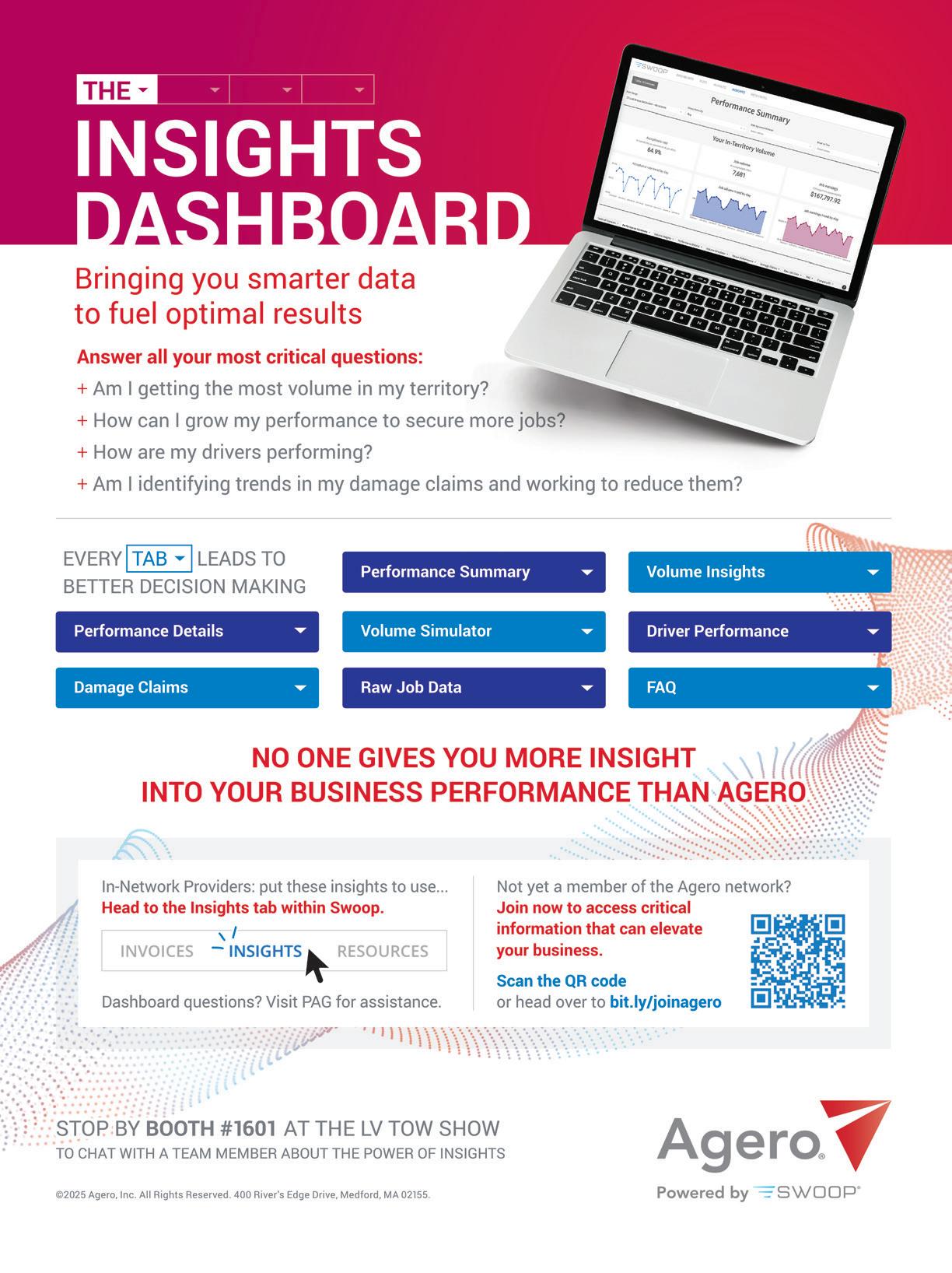


By Steve Temple
In the world of towing, many jobs aren’t always as straightforward as they initially appear. Just ask Lance Wayne, supervisor at Tri-State Towing and Recovery in Henderson, KY. An urgent early morning personal call came to him at 7:00 am on February 8th of this year. The owner of a nearby cement company frantically explained that one of his mixers had turned over in a private driveway. No big deal, right?
Then, Lance received a text photo showing the 70,000-pound loaded cement truck half-submerged in a lake, and covered in mud. Was Lance now beginning to feel a little daunted?
“Nah, it was just another day’s work,” Lance remarked offhandedly. “We handle a lot of tough recoveries.”
Yet this job posed a number of unexpected challenges, starting with the narrow road, which didn’t allow for much working area. Also, the levee was mushy. Just getting Tri-State’s 65-ton NRC stabilized on its outriggers required building up seven stacks of wood cribbing, consisting of fourfoot-long, 7 x 9-inch railroad ties.
The layer of mud on the truck complicated the rigging as well, as Lance’s crew couldn’t see where to attach the winch cables. To remove the silt, a rope was wrapped around the drum and the truck was rocked back and forth in a seesaw motion.
Another difficulty was attaching chains to the truck in the chilly, chest-deep water. But, the rigging crew successfully attached a 1/2-inch, Grade 100 bridle and a 5/8-inch, four-part line to the frame rails. Synthetic lines ran to a skid steer with a winch box, along with an excavator, so each served as a “dead man” to stabilize the setup.
“It took longer to get all the rigging on the truck, than pulling it out, due to the water and mud,”

Lance Wayne
Brent Marrow
Dustin Winstead
Luke Wayne
Skeeter Wayne RESPONDING PERSONNEL

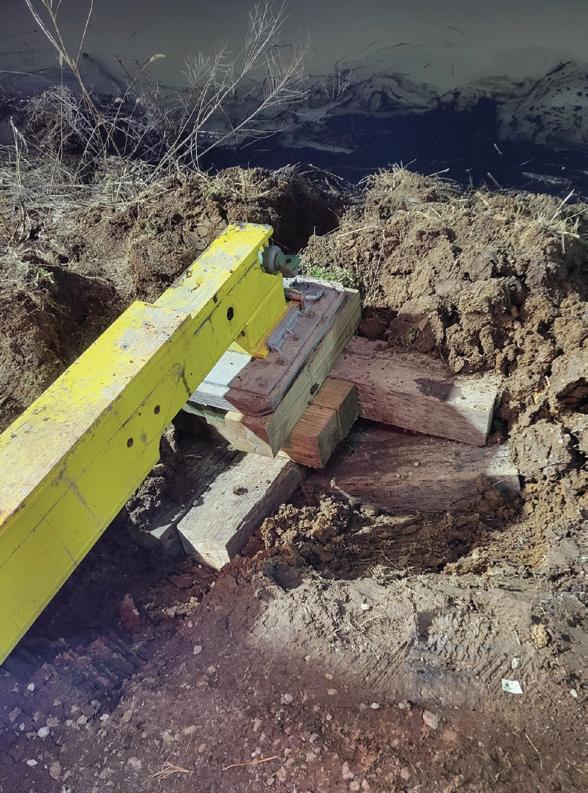
2024 NRC CSR65 65-ton rotator with a T880 Kenworth
2025 Vulcan V100 50-ton straight stick
NRC 35-ton slider
Caterpillar skid steer with a winch box
Excavator from the concrete company
Lance admitted. Two wreckers were needed for the procedure, a 2024 NRC CSR65 65-ton rotator, and a Vulcan V100 50-ton straight stick. The latter was a new tow truck scheduled to be delivered to TriState’s shop that same day. “I just

had it brought on scene instead, and we put it right to work,”
But his troubles weren’t over yet, as the levee was too soft for flat-towing the cement truck down the driveway. “We needed rock for the roadway,” Lance explained, so he asked the owner of the cement company to dump about 30 tons of gravel on the driveway.
Some 14 hours after getting that early-morning call, the cement truck was back on its wheels and hauled off to the cement factory, where it was later fitted with a new drum. TriState’s crew was careful to minimize any further damage during the recovery, so the cement truck was successfully put back into service— despite all the surprises!



By Steve Temple
Mother’s Off-Road Recovery owner, Cord Reside, located in Pennington, NJ found a new, unique niche for his ’87 Ford F-150. This green wrecker, ironically named “The Red Truck” because it started life as a red short-bed pickup, was initially built for recreational offroading. The rig runs a straight six-300, 4-speed manual trans with a 9-inch rear, along with a NP205 transfer case and Dana 44 front axle. Eventually, Cord entered the truck in the XRock Extreme Rock Crawling competition, also dubbed the “F1” of rock crawling.
For qualifying in the XRock series’ Mod Stock Class, the truck required some changes to comply with a few rules, starting with installing a roll cage. Also, the wheelbase had to be within three inches of the factory chassis, and it needed proper seats with a 5-point harness tied into the frame of the vehicle. The tires couldn’t be any larger than 37 inches, and the suspension had to have a factory-style setup. Though not a
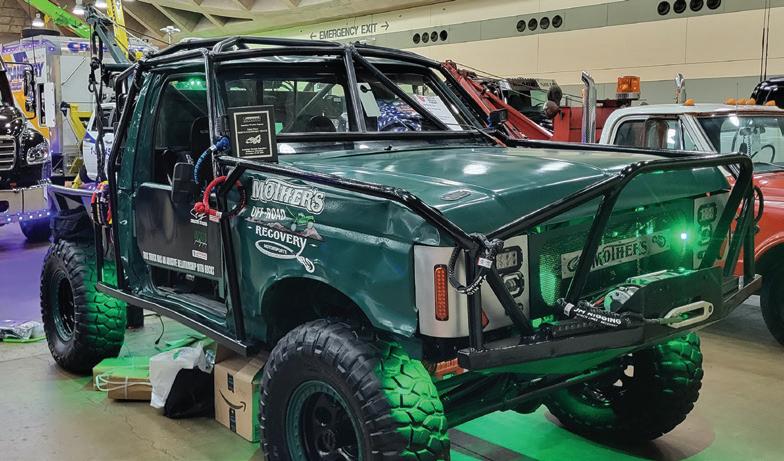



prerequisite, it was at this point that The Red Truck was painted green.
This second stage of the truck participating in the XRock series lasted three years. By the fourth year, though, interest waned in the Mod Stock class due to a new rule system.
“That year, I did more recovery for the Unlimited Class than I did anything else,” Cord recalled. But that came with its own set of problems, he pointed out.
The pickup had a hard time getting into a position where the front bumper winch had a clear line that was able to reach the “Unlimited” vehicles without getting caught in rocks. That meant it couldn’t create enough lift to pull a rig out of a bad spot.
“This made me want to build a concept rock crawler tow truck,” Cord explains. “The pickup bed was removed, and a friend had a wrecker boom that he bought because he wanted the original electric winch off it.”
At that point, Cord mounted a Holmes 290 mechanical boom to the frame, and some tubing was bent to build an area of protection around it. The truck then went down to Axt welding for additional modifications by AJ and Jason Axt to fabricate


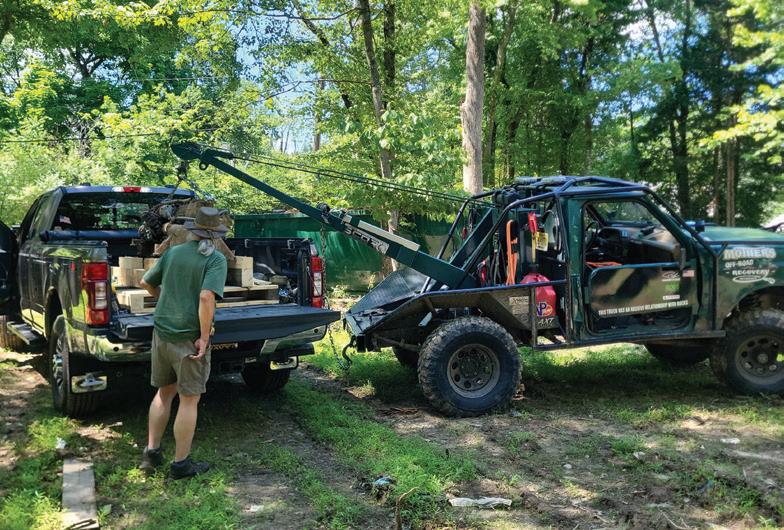
the rest of the wrecker body.
“AJ and I sat down and came up with a list of ‘needs’ the truck had to have,” Cord relates. These included a toolbox to hold a couple Blue Point tool kits, six snatch-block
holders, and a place to hang rigging equipment. Cord also required a couple five-gallon can holders, one for use as main fuel tank, the other for spare gas. Lastly, sheetmetal panels were attached to keep
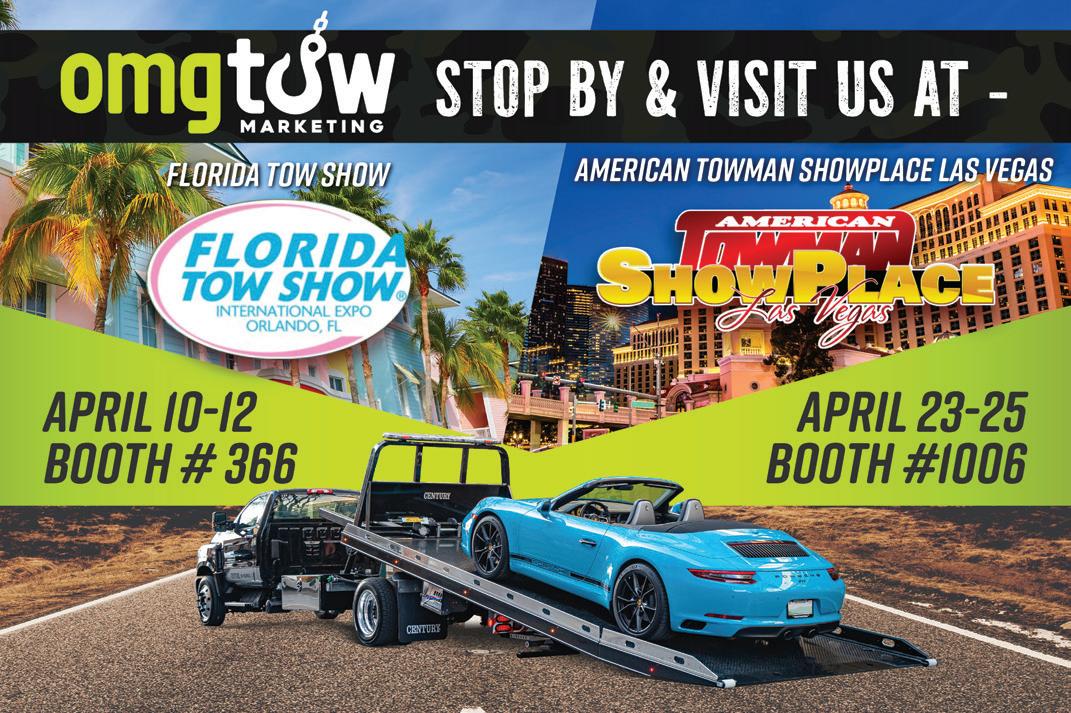


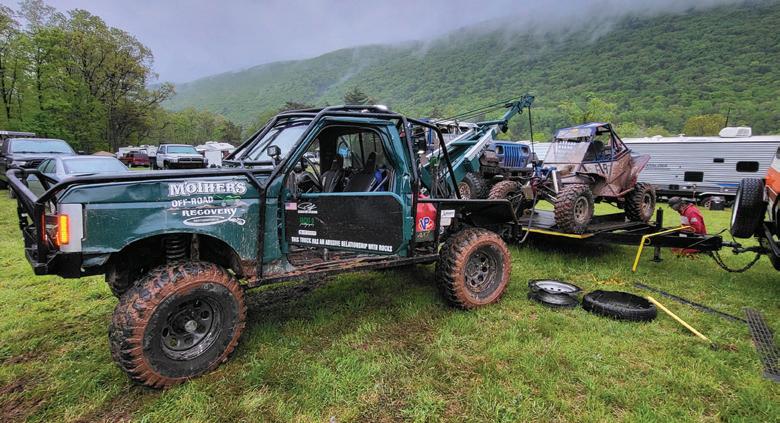
the inevitable layers of mud off the equipment. This setup proved itself, as three years later the truck is still doing its job.
Only one problem, though—the truck is too light. Weighing just under 7,000 pounds, and with a 116-inch wheelbase, the truck doesn't have enough front-end weight to haul some of the bigger off-road vehicles.
“Currently I have a new truck in the shop being built,” Cord says. It's a ’97 Ford F450, with a 7.3L diesel, C6 trans, 205 transfer case, and dual Dana 60 front axles, so the truck has both front and rear steer.” This wrecker will meet a growing need for his tow company.
“We mostly do off-road event recovery,” Cord notes. “We follow

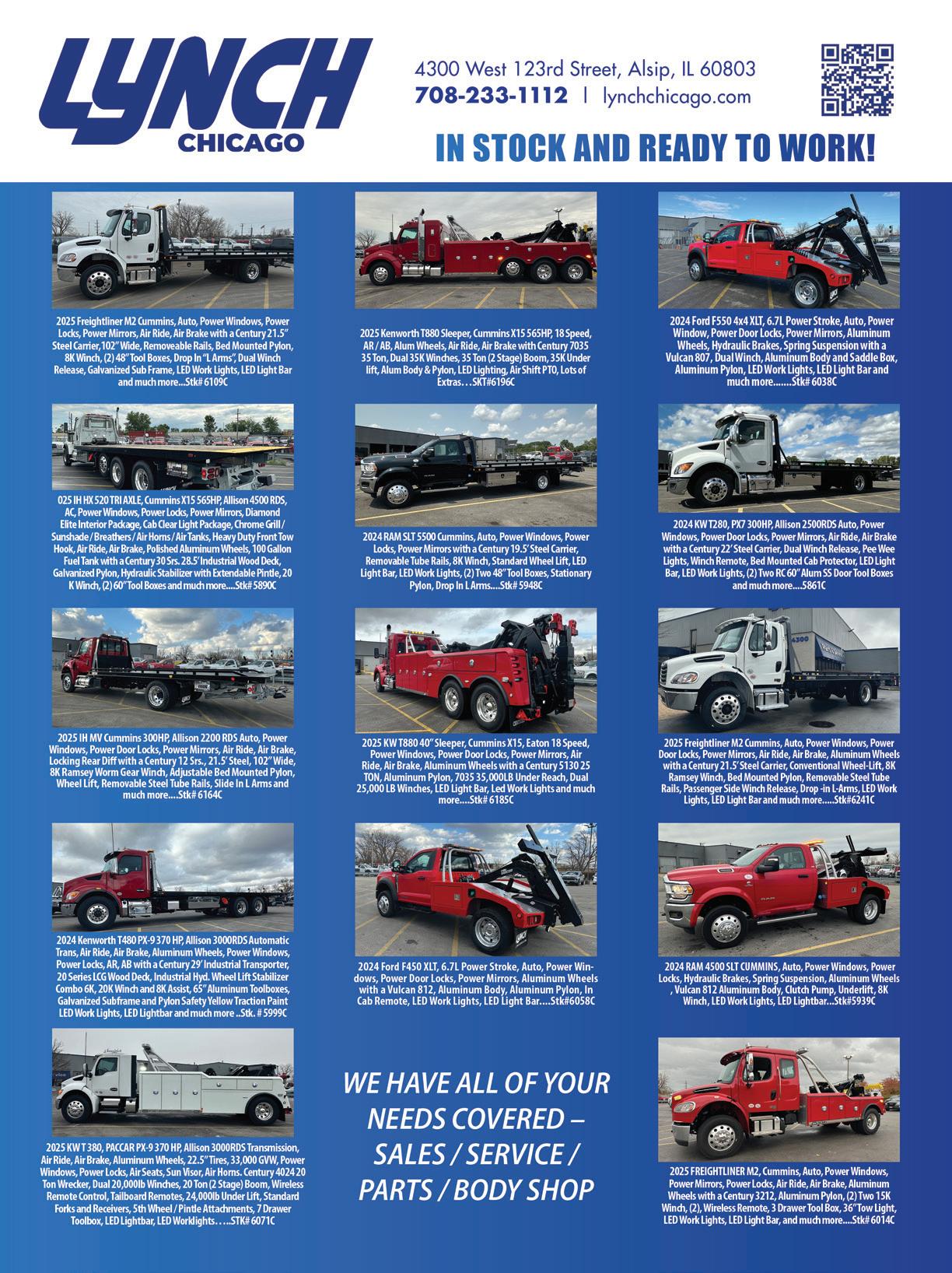

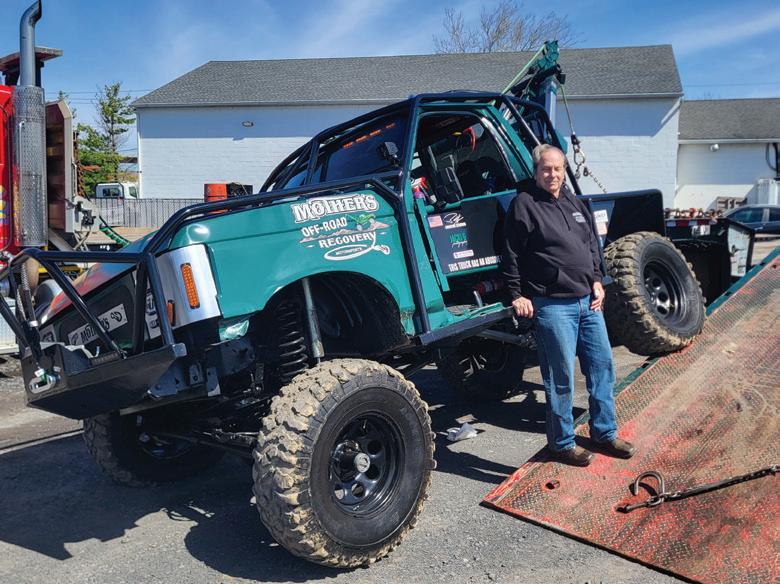
Robs Towing of Bristol TWP invited Mother’s to “cars and coffee.” Terry Reside, president of Mother's Recovery Inc (aka "The Old Man”) enjoyed getting out to look at cars and show off his off-road rig.
a few different events at XRock Extreme Rock Crawling, Ultra4/ King of the Hammers, and Line Mountain 4Wheelers. Cord and his
team look forward to continuing their participation in these events and pushing the limits alongside other competitors.


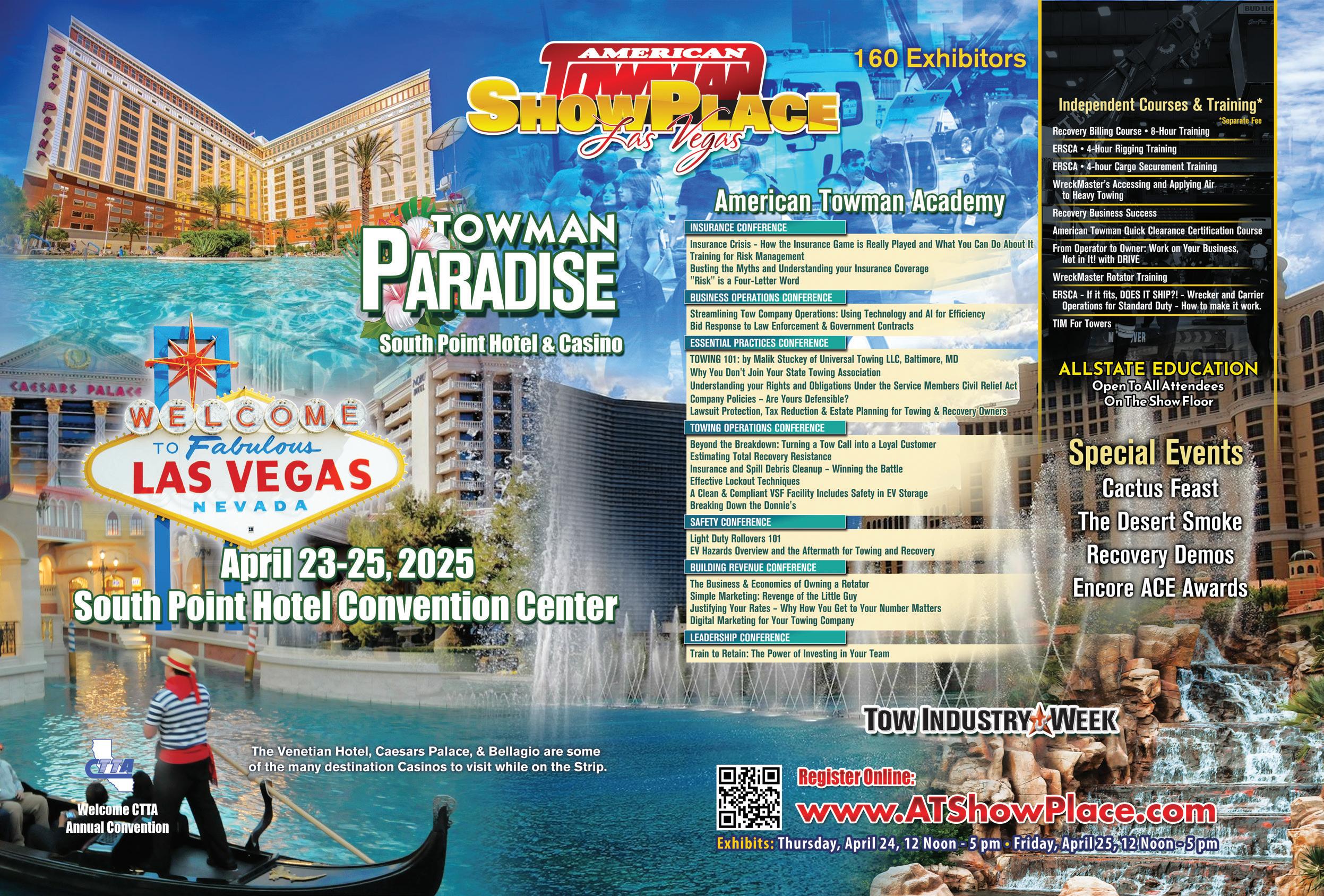


Access Tools Booth#1008 - pg. 57
Acrisure
Advanced Track Solutions
Agero powered by Swoop Booth#1601 - pg. 35
Alkeme Automotive
Allstate Roadside Booth#104 - pg. 29 Alt Enterprises Booth#1225 - pg. 33
American Key Supply American Towman Magazine
Ascentium Capital Booth#116 - pg. 25
Auto Data Direct Booth#1106 - pg. 65
Automobile Club of Southern California
Autura Booth#904 - pg. 44
Axle Covers
Azuga, A Bridgestone Company
B/A Products Co.
Balboa Capital, a division of Ameris Bank Beacon Funding Brock Supply
Copart Auto Auctions Booth#J2 - pg. 3
CTTA/ERSCA
Curtis J Vernon Insurance Agency
Cutco
DewEze Mfg. Booth#609 - pg. 27
DiBuduo & DeFendis Insurance Brokers
Doepker Trailers
DRIVE
Dual-Tech Booth#60 4- pg. 34
East Coast Truck & Trailer SalesBooth#1126- pg. MW70
ECS
Energy Security Agency
Envue Telematics
Enterprise
Star Registration FleetNet America
Freeway Service Patrol (FSP)
Fullbay
G.L. Anderson Insurance Services
Gaston & Sheehan Auctioneers
GEICO
Geotab Powered by Fleet Wolf
Golden West Towing Equipment. LP
& Chevron est, a division of West Coast Towing Eq. LP
Golight Booth#1200 - pg. 28
GovDeals
Greasweep
Gulf Atlantic Supply
Guttman Energy
Horizon Motor
Hot Shot’s Secret
Huntington National Bank
Hytera US
I-Lien
IAA Holdings
ICW Group
In The Ditch Towing Products
Isuzu Commercial Truck of America
Booth#119 - pg. 9
iTow
James Parker Insurance
Journey Business Solutions
Kalyn Siebert
Khasim Insurance Agency
Booth#1000 - pg. MW 73
Landoll Company Booth#1517 - pg. 13
Lien Enforcement Booth#L1 - pg. MW68
Lien Receivables
Lodar USA Booth#1122 - pg. 19
Lubnau Gonzalez Insurance Agency
Booth#823- pg. MW76
Lynch Denver
MAXXIMA
McCandless International Trucks
MIDCO SALES
Midtronics
Mike Keith Insurance Booth#1615- pg. MW75
Miller Industries Booth#418 - pg. C2
Mobile Relay Associates
Murphy Bank
Nation Safe Drivers
National Automobile Club
Nevada State Tow Association
Nite Beams Products
NRC Industries
OMG Tow Marketing Booth#1006 - pg. 42
OmniMed
OnCallGPS Video
Onspot Auto Tire Chains
ParkM
parkplus.ai
Peak Auto Auctions
PeakPTT Booth#200 - pg. 27
Peddle
Penny Pockets
Phoenix USA Booth#1115 - pg. 58
Professional Dispatch Service
Rage LED
RC Industries
REAL Mobile
Rivian Automotive
RLX
Roadside Protect
Roadsider
RoadSync
Robertson Ryan Tow Truck Insurance
Robinson Oil
Rocky Mountain Wrecker Sales
RP Recovery
Rush Towing Systems
Santander Bank, N.A. Booth#510 - pg. C3
Sea Crest Insurance Agency
Service Member Data
Signature Card Processing
Southern California Tow Equipment
Stamp Works
Star Blink Products
Steck Mfg. Co. by Milton Industries Booth#1118 - pg. 52
TD-Vision
TEC Equipment
Telecom Tech Solutions
The Exchange | 24/7 Dispatch
Todd Equipment
TOMAR Electronics
Towkraft
Tow Industries Booth#217 - pg. MW74
Tow World
Towbook Management Software
Booth#1102 - pg. 4-5
Towing.com
Towsurance
TowToolz
Trail King Industries
Truck Body Sales
Truck In A Box Booth#912 - pg. 3
Truckparkingclub.coim
US Fleet Tracking (USFT)
Booth#500 - pg. 59
Utah Professional Towing Alliance
Verdant Commercial Capital
Vestige View
Wellnex Group
Whelen Engineering Co.
Whiterail
Will-Burt Booth#1215 - pg. 55
Williamette Financial
WreckMaster
Ynot Services
Zacklift International
Zellner Insurance Agency
Zip’s AW Direct
Booth#918, 822 - pg. 17, 32, 41


By Brian J. Riker
In their relentless pursuit for change and recognition, towers once again met on Capitol Hill on February 25 to stand up for industry rights, where they addressed roadside safety, reasonable regulatory governance, and other critical issues. With nearly 90 attendees from 27 states, the full spectrum of the industry was well represented, and included companies with just a few trucks to the largest of consolidated operations, as well as towing equipment manufacturers.
The event opened with a working breakfast where attendees had a chance to meet with each other, learn a little
about their fellow towers from across the nation, and work with the team from TSG (Tremont Strategies Group), the lobbyist firm representing TRAA (Towing and Recovery Association of America) for the past seven years.
After breakfast, a legislative workshop was held to educate attendees on key issues and effective strategies for addressing them, tailored to specific congressional committees and areas of focus. The legislative priorities for the 119th Congress, which are specific to towing, include
improving the ability for towers to respond effectively on interstate roadways, considering towing industry concerns when implementing EV (electric vehicle) policies, and supporting the Prevention of Roadside Deaths Act.
The issue related to improving the ability for towers to respond effectively on interstate roadways is complex but achievable. TRAA members are seeking relief from certain weights and measures controls, namely the ability to exceed axle weights and overall gross combination weight and length restrictions for emergency or “first moves” of wrecked or disabled vehicles. This will allow, but not mandate, the use of one tow truck and one operator to remove combination vehicles without the need to separate them at roadside, which very often exposes towers to additional risks.
EV policy is currently a hotly debated topic and TRAA members are asking


EVs to be considered when policies are implemented. To that effect, TRAA is asking Congress to sign their letter to Transportation Secretary Duffy, an effort led by Congressman Jay Obernolte (R-CA), which would request that the USDOT (U.S. Department of Transportation) work with the towing industry to issue updated guidance for best practices. These practices would include responding to EV fires, along with establishing a database of roadside incidents involving EV fires.
As for supporting the Prevention of Roadside Deaths Act, TRAA is asking Members of Congress to cosponsor upcoming legislation from Representatives Carter and Flood which would improve reporting and accountability by requiring the USDOT to collect, analyze, and publish detailed data on disabled roadside vehicle crashes. This measure would also use existing funds to help State authorities improve data collection efforts. Without this data, the towing industry is powerless to effect change in Washington, as everything requires a study and solid information before any serious consideration is given to an issue.
The workshop included instruction on how to make the most of their scheduled meetings with Members of Congress by using a role-play sample meeting to help break the tension for the first timers. During this session, Jim Jennings of Emerald Towing, a Guardian Company, played the role of tower with expert precision. Chet Atkins, a former Member of Congress
and now a Partner with TSG, along with Alyssa Ring, the primary lobbyist from TSG that works on towing issues, played the role of the Congressional Staffers. This provided a comfort level and familiarity to the attendees so that they could be comfortable when conducting their own meetings on Wednesday.
Later Tuesday afternoon, TRAA hosted a Fireside Chat (sans the fireplace), with Adrienne Camire, FMCSA Senior Advisor to the Administrator and Matt Schuck, FMCSA Director of Communications and Senior Governmental Affairs Officer. They discussed several issues towers face and how the Federal Motor Carrier Safety Administration may be able to help.
Jim Jennings and your author, Brian Riker, (in my role as Legislative Director of the Pennsylvania Towing Association and Chair of the TRAA Legislative Advocacy Network/ Lobbyist Member of the TRAA), shared the stage as co-hosts of this insightful and engaging session. We took turns asking questions about the Agency’s possible role in tower safety and other priorities from the Trump Administration.
It is important to note that Adrienne Camire is no stranger to transportation issues, having served as the Chief Counsel at the Federal Highway Administration (FHWA) during the first Trump Administration. She is well versed in transportation policy, including roadway safety, and has



indicated she is open to a collaborative environment with all transportation industry partners.
During this discussion, the FMCSA representatives emphasized that the Administration is committed to roadway safety, including all highway responders, and that they are looking forward to working with TRAA in any capacity possible to improve safety.

Ms. Camire and Mr. Schuck expressed their willingness to communicate openly with the industry, and offered an open-door policy for TRAA to bring issues directly to them for discussion. Ms. Camire even expressed interest in a tow truck ride-along, and several towers in attendance readily offered to make that experience a reality.
On Wednesday morning, the towers kicked into high gear, launching into a packed schedule of 112 individual
meetings with Members of Congress and their staff from across the political spectrum. The goal was to meet with Members on key committees of influence over areas that directly affect the towing industry, with a focus on meetings where TRAA had constituents in attendance. It is always more effective when an individual constituent is present to tell their story, and connect on a personal level with the staffers.




To accomplish this feat, the towers were grouped together by state or region, with a Team Captain appointed to help navigate the complexities of the Capitol Building and the four Congressional office buildings. Team Captains were selected from prior attendees who demonstrated a certain savvy for facilitating
meetings and an understanding of the lobbying process. TRAA was fortunate to have 13 Captains volunteer this year, and will be looking for even more in 2026.
After the individual meetings concluded, the attendees were ushered to a meet-and-greet with Members of Congress, hosted in the Dirksen Senate Office Building. This ideal access was an unexpected bonus on a day when

Congress was in session and floor votes were being called.
TRAA, working closely with TSG, and leveraging the carefully curated relationships developed over the last several years, were able to arrange eight visits from Members of Congress, including returning favorites like Jared Golden (D-ME-02), and Dina Titus (DNV-01) who has served in Congress since 2009 and currently is the Ranking Member of the Subcommittee on Economic Development, Public Buildings and Emergency Management.
Also meeting with TRAA were Freshmen Representatives such as Dave Taylor (R-OH-02), who serves on the House Transportation and Infrastructure Committee (T&I), and Congresswoman Laura Gillen (D-NY-04), who also serves on the House T&I Committee, and has a long history representing businesses as a commercial litigator.
Another highlight of the Meet-andGreet was Representative Greg Stanton (D-AZ-04), another T&I Committee delegate who led the TRAA’s letter to the FTC last year, combatting inclusion of the towing industry into the “junk fee” rule-making. Congressman Stanton, known for his bipartisan approach, has been very supportive of the TRAA in the past, which everyone is hopeful will continue in the 119th Congress.
Capping off the events on The Hill on Wednesday afternoon, attendees were treated to a private tour of the Capitol Building led by one of TRAA’s best supporters, Representative Jim McGovern (D-MA-02). Congressman McGovern is the Ranking Member of the powerful House Committee on Rules, which is the group that decides which bills make their way to the floor for a vote, and how the process will unfold. Representative McGovern has long supported the towing industry, and always goes out of his way to make towers feel welcome and at home while in Washington.

He previously led the charge for a National Move Over Day resolution and truly understands the issues that towers face daily.
The official activities concluded
later Wednesday with a working dinner where the events of the day were discussed. Team Captains reported on their individual meetings and noted who might be expected to


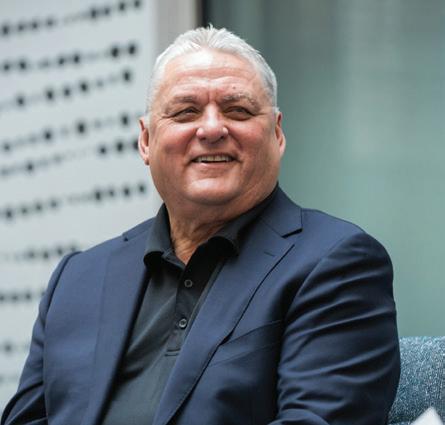
be supportive of the issues in the 119th Congress. The consensus was that the next two years will be challenging, however, the overall atmosphere is positive for small businesses, including towers.
“With a Highway Bill being developed this year, now is the time to push forward with towing-related legislation that makes sense and will provide the maximum safety impact,” stated Cynthia Martineau, TRAA’s Executive Director. “Once the highway bill is complete, and much needed safety legislation is included, then the time will be right to push forward other business issues, such as the lack of payment from unscrupulous insurance companies, and trucking companies that are woefully underinsured.”
TRAA President George Kuntz summed up the multi-day event by saying: “The road ahead awaits, and as this event grows each year, so does TRAA’s ability to make change happen. It is thanks to everyone in attendance that we have the influence we do. Please tell a friend about your experiences here this week and ask them to come along next year, so together, we can accomplish even more for this great industry.”
These are exciting times for the towing industry, with backing from everyone involved. The industry can finally have an effective voice related to legislative and regulatory issues on a national level. Supporting both state and national associations is critical to ensuring the well-being and livelihood of towers.





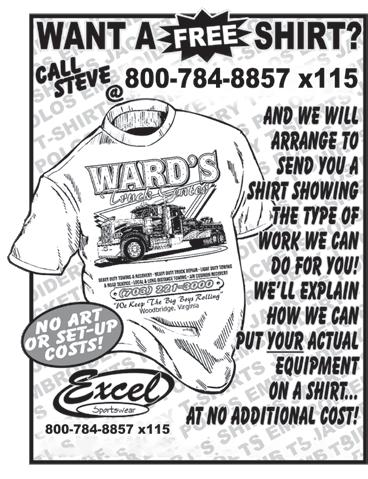









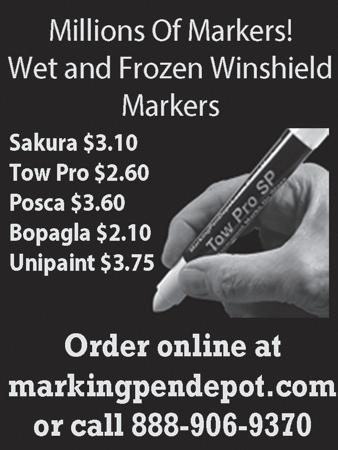

By Steve Temple

Chacon Towing of El Paso, Texas is aptly named, not only because it’s run by the Chacon family, Luis and his two sons Josh and Lance, but also to the meaning of their surname.
Translated from Spanish, Chacon refers to a gecko lizard, which has many symbolic meanings across various cultures, including good fortune, protection, and renewal.
Luis and his wife Roxana
founded the company back in 2014 with a flatbed on a ’97 GMC 6500. Luis had the good fortune to secure his winning bid of $7000 for the truck, and picked it up in Colorado to tow it back to Texas. There it sat


Engine: Cummins X-15
Chassis: 2019 Peterbilt 567
Wrecker: 2020 Jerr-Dan
JD35 Heavy Duty Integrated Wrecker
Custom Features: Rubrail dress-up kit; aluminum 39-inch pylon with dress-up kit; rear camera system, LED lights, Whelen light bar wing
Graphics: TSW Grafix

for a while, as Luis was unfamiliar with how to operate it, but was able to learn by watching YouTube videos and other towers.
Once he was confident with his abilities, Luis began advertising
his tow business on Craigslist and Google, and later got a call from a motor club that needed a reliable towman. From there his business took off, and Luis points out that Roxana was instrumental in the management and growth of the company—but sadly passed away in 2020. He also credits American Towman magazine and its TowXpo as having significant impacts.
“That opened up a whole new world for me,” he exclaims of the magazine. “All the products and stories about other towers.” Luis also went to the TowXpo, and after
the third year of attending, knew he had to go to all of the American Towman events.“It helped my business so much,” he adds. “I was able to grow my company thanks to the magazine and shows.” Today, the company has prospered, with a fleet of about 80 trucks servicing El Paso and San Antonio, TX and Albuquerque, NM.
Getting back to the gecko’s good traits, they also apply to a recovery in late February of a Nissan 350Z that crashed down a 200-foot ravine. Fortunately, the driver survived with only minor injuries, but


getting the car back up on the road was no simple task. Good thing a gecko is also known for its climbing ability on inclines!
Chacon dispatched its JerrDan JD35 Heavy Duty Integrated Wrecker, fitted with a 35-ton boom, plus two 35,000-lb, two-speed DP hydraulic winches wrapped with 5/8-inch x 250 feet of wire rope. They needed every bit of this winch line to recover the Nissan.
After surveying the scene, Chacon Towing had their operator, Angel Oliva, gear up and rappel down to rig the casualty car to the Jerr-Dan’s heavy-duty winch. The cliffside was steep and slippery, strewn with big boulders that created obstacles when hauling the vehicle back up.
“We’d get over one and then stuck on another,” Josh explained. But the gecko was watching over them, as they got the car safely back up on level ground a couple hours later. Chacon’s crew then loaded it onto a light-duty Jerr-Dan flatbed, under the watchful eyes of police and fire personnel.
Josh says Chacon Towing’s JerrDan JD35 wrecker has provided good fortune and protection in a number of other recoveries as well, ranging from semi rollovers to a car stuck in a canal. The gecko has been good to them.

CONTINUED FROM PAGE 32
For over 25 years, Integrated Vehicle Leasing has served as a trusted financial partner to the towing industry, offering customized leasing and financing solutions to businesses across the country. This firm is familiar with the unique challenges faced by tow truck operators, and the goal has always been to provide flexible, reliable financing options that allow clients to grow and thrive. As Integrated celebrates this 25-year milestone, the company looks forward to continuing support to the hardworking professionals who keep roads safe and moving.
Source: integratedleasing.com
After a transitional year, Sholom Jacobson is back at Stamp Works, eager to serve towers with tow truck magnets and key chains. He plans to attend American Towman’s ShowPlace-Las Vegas, as well as other upcoming tow shows.
Sholom looks forward to meeting up with both old and new friends in the industry. With trusty office manager Natalie, he’s prepared to replicate your custom tow
truck as a unique magnet to give out to customers—reminding them of who to call for their towing needs.
Source: stampworks.net



Steve Calitri Editor-in-Chief scalitri@towman.com
The American Towman Academy Online is kicking off a leadership series on May 22 that features a podcast style webinar with three industry stalwarts. The May webinar focuses on “Recruiting and Keeping Tow Operators.” The threeveteran tow-fleet owners and managers joining the session have over 90 years combined experience in dealing with the continual challenge of fielding a qualified driver-force. Also, all three men heading up this leadership webinar were at one time or another honored as Towman of the Year.
Geoff Nienstedt owns and operates Road Runner Towing & Recovery in Schwertz, Texas. He also moderates the Recovery Alley Podcast. He claims that driver turnover is rare at Road Runner, and can attribute that to several management and leadership practices. Nienstedt will moderate the May webinar that features two other well-known and respected towmen, Tom Tedford and Ron Myers.
Tedford is the Chief Operating Officer of Guardian Fleet Services, the corporate umbrella of a dozen independent tow fleets across the nation. Before joining Guardian, he was in executive management at United Road Towing. Tom grew up in the industry as a tow operator and company manager, and has years of experience in driver recruitment and retainment.
Ron Myers owns and operates Pine Tree Towing in Ohio, and is also one of the most experienced and respected leaders in the towing industry.
These towmen are extremely dedicated, talented, and innovative, and have contributed to positive change in the way tow operations are run. Having three industry treasures up on the screen together, addressing this most critical topic, will surely be a compelling event. Tow business owners and managers dealing with the challenge of hiring and keeping good tow operators will want to sign onto this webinar.
My own involvement in the towing industry has spanned 40 years over five decades. In all of those decades, I’ve seen that hiring and keeping good tow operators has been a huge challenge. Truth is, year after year, the challenge grows more difficult.
The dynamics today that make it an ongoing challenge are myriad: stiff trucking industry competition for drivers; a present-day culture breeding people not fit for outdoor, hands-on tasks; and a dangerous work environment on the roadsides. It does not help that the towing industry at large struggles to be profitable and pay living wages that can attract the right people for this work.
The minimum wage today needs to be $30 an hour, after a 60-day trial period. Many tow bosses may object to me saying this, but this is the reality. Tow companies need to be profitable enough to afford a competent and stable driver force.
The subject of this upcoming webinar begs the question: is the towing industry doing anything in a unified manner to recruit capable men and women? I always think of the old commercials for the Marines (“We’re looking for a few good men”) and the Army (“Be all you can be”), and how these services sold the most challenging aspects of military training to young adults.
There are few jobs in America as interesting and challenging as recovery work. The average tow involves helping a motorist and/or serving law enforcement. The prospects of selling this job to young adults would be a dream-task for any public relations or advertising firm. There is a certain kind of young person who would fight for a job like this.
Tune in as Geoff, Tom, and Ron share their insights on the challenges and solutions for hiring and retaining qualified tow operators.



A trial is set for Shaun David Rambow, 45, charged with first-degree robbery and assault after allegedly attacking a repossession agent attempting to recover his car. Prosecutors claim Rambow pulled off a dramatic escape in May 2024, evading two repo men by leaping into his car and driving it off a lift truck while one of the agents’ arms was still inside the vehicle. The injured agent pressed charges, and Rambow now faces charges of robbery, assault, reckless endangerment, and motor vehicle theft. Authorities allege this was not Rambow’s first encounter with repo men. In a previous incident, he managed to escape as they tried to tow his car. Rambow pleaded not guilty to the charges.
Source: curepossession.com

A deadly crash occurred on I-10 in Arizona, resulting in a multi-vehicle collision involving several semi-trucks. Arizona Department of Public Safety (DPS) officials confirm that six people have died, and at least 13 others have been hospitalized, with multiple vehicles catching fire. Firefighters worked tirelessly in high winds to extinguish the flames and rescue those trapped in the wreckage.
The crash appears to have been triggered by a single accident that caused a chain reaction involving both passenger vehicles and semi-trucks. The conditions were worsened by heavy dust blowing across the area, which had already prompted warnings from the National Weather Service. The dust storm contributed to poor visibility, likely playing a role in the crash.
Source: nbcnews.com
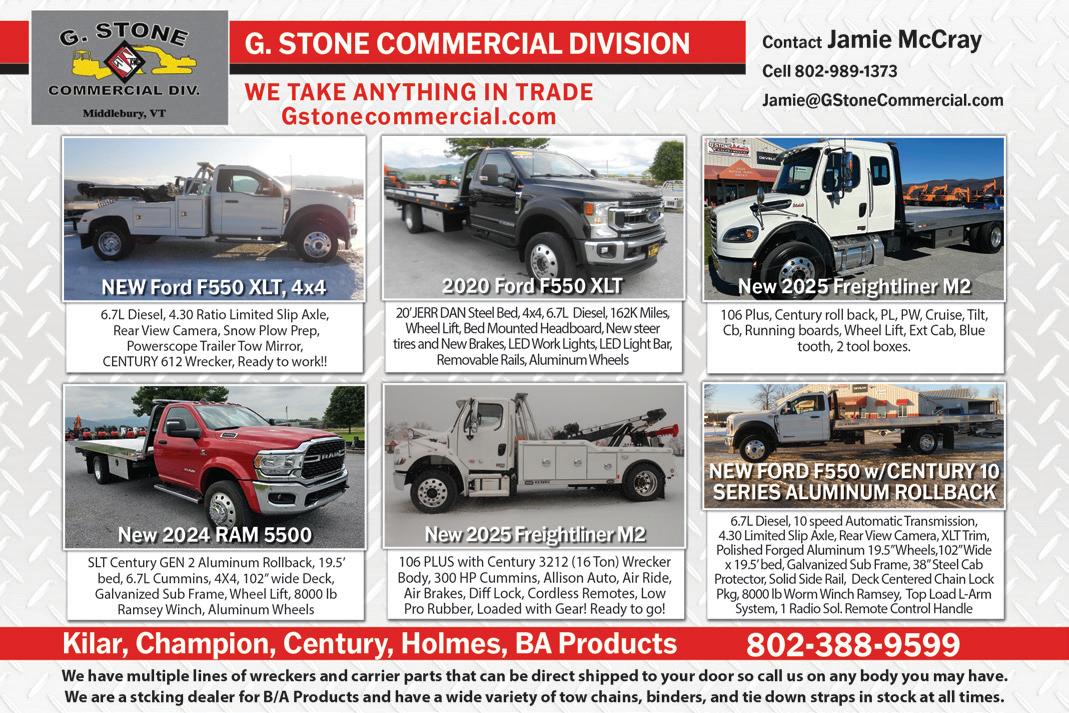

As highlighted in Editor-in-Chief Steven Calitri’s “The Lowdown” column in this issue, there’s a new leadership series starting on May 22 on American Towman Academy Online. The webinar will be focusing on a common concerns for tow business managers: “Recruiting and Keeping Tow Operators.”
A panel of three seasoned pros from the towing industry, Geoff Nienstedt, Tom Tedford and Ron Myers, all of whom have been previously honored as Towman of the Year, will be heading up this special presentation. Tow business owners and managers dealing with the challenge of hiring and keeping good tow operators will certainly benefit from this informative program.
For details on attending, go to https://americantowman.com/academy.
Fuel card skimming has become a growing concern for truck fleets, with scammers installing deceptive devices on truck stop fuel pumps to capture payment card information. Once obtained, fraudsters use the stolen data for unauthorized purchases until fleet managers intervene. However, the trucking industry has made significant progress in addressing this issue.
Industry leaders highlight the shift toward digital payment systems as a major defense against fuel card skimming. According to Spencer Barkoff, president of Relay Payments, the transition to cardless payments has significantly reduced the occurrence of skimming. Digital solutions eliminate the need for physical cards, removing the primary target for scammers.
Teaming up with telematics technology, fleets can now track high-risk areas where skimming has been prevalent. Erika Voss, vice president of DAT
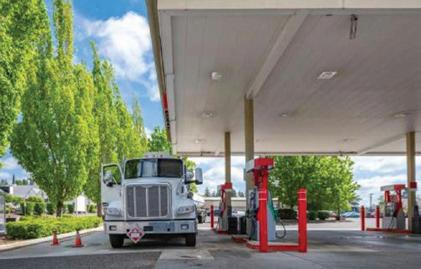
Freight & Analytics, recommends drivers avoid sketchy locations and inspect card readers for signs of tampering. She also emphasizes covering the keypad when entering security codes.
As skimming declines, scammers are turning to more advanced tactics, using AI to deceive individuals into revealing login credentials and multi-factor codes. Experts stress the importance of educating employees to recognize and reject these scams. Fraud detection software is also playing a key role in safeguarding against these increasingly sophisticated threats.
Source: ttnews.com
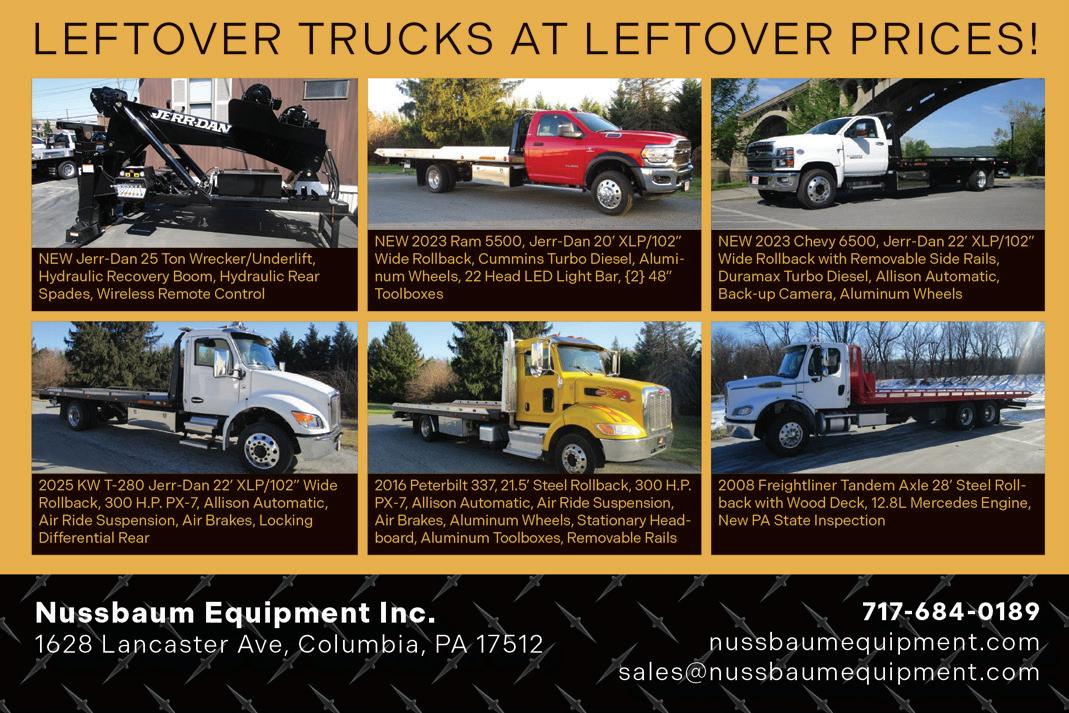






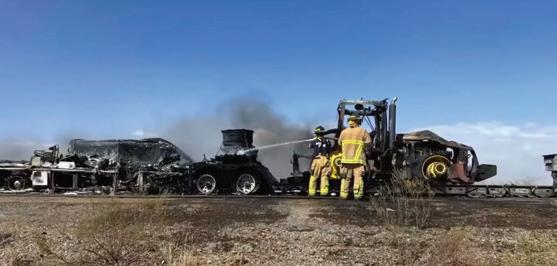
A trial is set for Shaun David Rambow, 45, charged with first-degree robbery and assault after allegedly attacking a repossession agent attempting to recover his car. Prosecutors claim Rambow pulled off a dramatic escape in May 2024, evading two repo men by leaping into his car and driving it off a lift truck while one of the agents’ arms was still inside the vehicle. The injured agent pressed charges, and Rambow now faces charges of robbery, assault, reckless

endangerment, and motor vehicle theft. Authorities allege this was not Rambow’s first encounter with repo men. In a previous incident, he managed to escape as they tried to tow his car. Rambow pleaded not guilty to the charges.
Source: curepossession.com
A deadly crash occurred on I-10 in Arizona, resulting in a multi-vehicle collision involving several semi-

trucks. Arizona Department of Public Safety (DPS) officials confirm that six people have died, and at least 13 others have been hospitalized, with multiple vehicles catching fire. Firefighters worked tirelessly in high winds to extinguish the flames and rescue those trapped in the wreckage.
The crash appears to have been triggered by a single accident that caused a chain reaction involving both passenger vehicles and semi-trucks. The conditions were worsened by heavy dust blowing across the area, which had already prompted warnings from the National Weather Service. The dust storm contributed to poor visibility, likely playing a role in the crash.
Source: nbcnews.com
As highlighted in Editor-in-Chief Steven Calitri’s “The Lowdown” column in this issue, there’s a new leadership series starting on May 22 on American Towman Academy Online. The webinar will be focusing on a common concerns for tow business managers: “Recruiting and Keeping Tow Operators.”
A panel of three seasoned pros from the towing industry, Geoff Nienstedt, Tom Tedford and Ron Myers, all of whom have been previously honored as Towman of the Year, will be heading up this special presentation. Tow business owners and managers dealing with the challenge of hiring and keeping good tow operators will certainly benefit from this informative program.
For details on attending, go to americantowman.com/academy.
Fuel card skimming has become a growing concern for truck fleets, with scammers installing deceptive devices on truck stop fuel pumps to capture payment card information. Once obtained, fraudsters use the stolen data for unauthorized purchases until fleet managers intervene. However, the trucking industry has made significant progress in addressing this issue.
Industry leaders highlight the ◀



shift toward digital payment systems as a major defense against fuel card skimming. According to Spencer Barkoff, president of Relay Payments, the transition to cardless payments has significantly reduced the occurrence of skimming. Digital solutions eliminate the need for physical cards, removing the primary target for scammers.
Teaming up with telematics technology, fleets can now track high-risk areas where skimming has been prevalent. Erika Voss, vice president of DAT Freight & Analytics, recommends drivers avoid sketchy locations and inspect card readers for signs of tampering. She also emphasizes covering the keypad when entering security codes.
As skimming declines, scammers are turning to more advanced tactics, using AI to deceive individuals into revealing login credentials and multi-factor codes. Experts stress the importance of educating employees to recognize and reject these scams. Fraud detection software is also playing
a key role in safeguarding against these increasingly sophisticated threats.
Source: ttnews.com
The Federal Motor Carrier Safety Administration (FMCSA) has appointed Adrienne Camire as its acting administrator. Camire, a veteran of the Trump administration, previously served as chief counsel for the Federal Highway Administration (FHWA), where she managed legal services for federal aid highway programs. With over 20 years of experience in legal, regulatory, and compliance roles, Camire brings significant expertise to the position.
In her new role, Camire will lead efforts to enhance commercial motor vehicle safety and improve the efficiency of the nation’s transportation systems. Transportation Secretary Sean Duffy praised her leadership, emphasizing her commitment to safety and her

Adrienne Camire
ability to make America’s roads safer. Camire expressed gratitude for the opportunity, stating, “I’m honored to lead FMCSA in its mission to prevent commercial motor vehicle crashes and injuries.”
Source: ttnews.com







A trial is set for Shaun David Rambow, 45, charged with first-degree robbery and assault after allegedly attacking a repossession agent attempting to recover his car. Prosecutors claim Rambow pulled off a dramatic escape in May 2024, evading two repo men by leaping into his car and driving it off a lift truck while one of the agents’ arms was still in-
side the vehicle. The injured agent pressed charges, and Rambow now faces charges of robbery, assault, reckless endangerment, and motor vehicle theft. Authorities allege this was not Rambow’s first encounter with repo men. In a previous incident, he managed to escape as they tried to tow his car. Rambow pleaded not guilty to the charges.
Source: curepossession.com

A deadly crash occurred on I-10 in Arizona, resulting in a multi-vehicle collision involving several semi-trucks. Arizona Department of Public Safety (DPS) officials confirm that six people have died, and at least 13 others have been hospitalized, with multiple vehicles catching fire. Firefighters worked tirelessly in high winds to extinguish the flames and rescue those trapped in the wreckage.

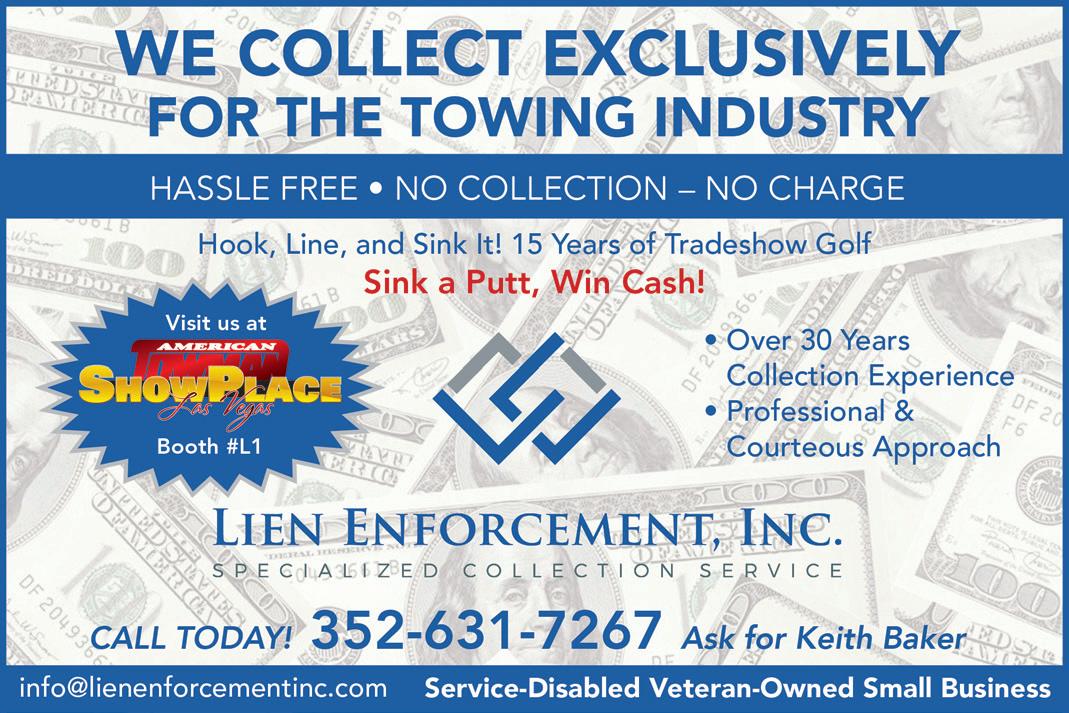


The crash appears to have been triggered by a single accident that caused a chain reaction involving both passenger vehicles and semi-trucks. The conditions were worsened by heavy dust blowing across the area, which had already prompted warnings from the National Weather Service. The dust storm contributed to poor visibility, likely playing a role in the crash.
Source: nbcnews.com
As highlighted in Editor-in-Chief Steven Calitri’s “The Lowdown” column in this issue, there’s a new leadership series starting on May 22 on American Towman Academy Online. The webinar will be focusing on a common concerns for tow business managers: “Recruiting and Keeping Tow Operators.”
A panel of three seasoned pros from the towing industry, Geoff Nienstedt, Tom Tedford and Ron Myers, all of whom have been previously honored ◀

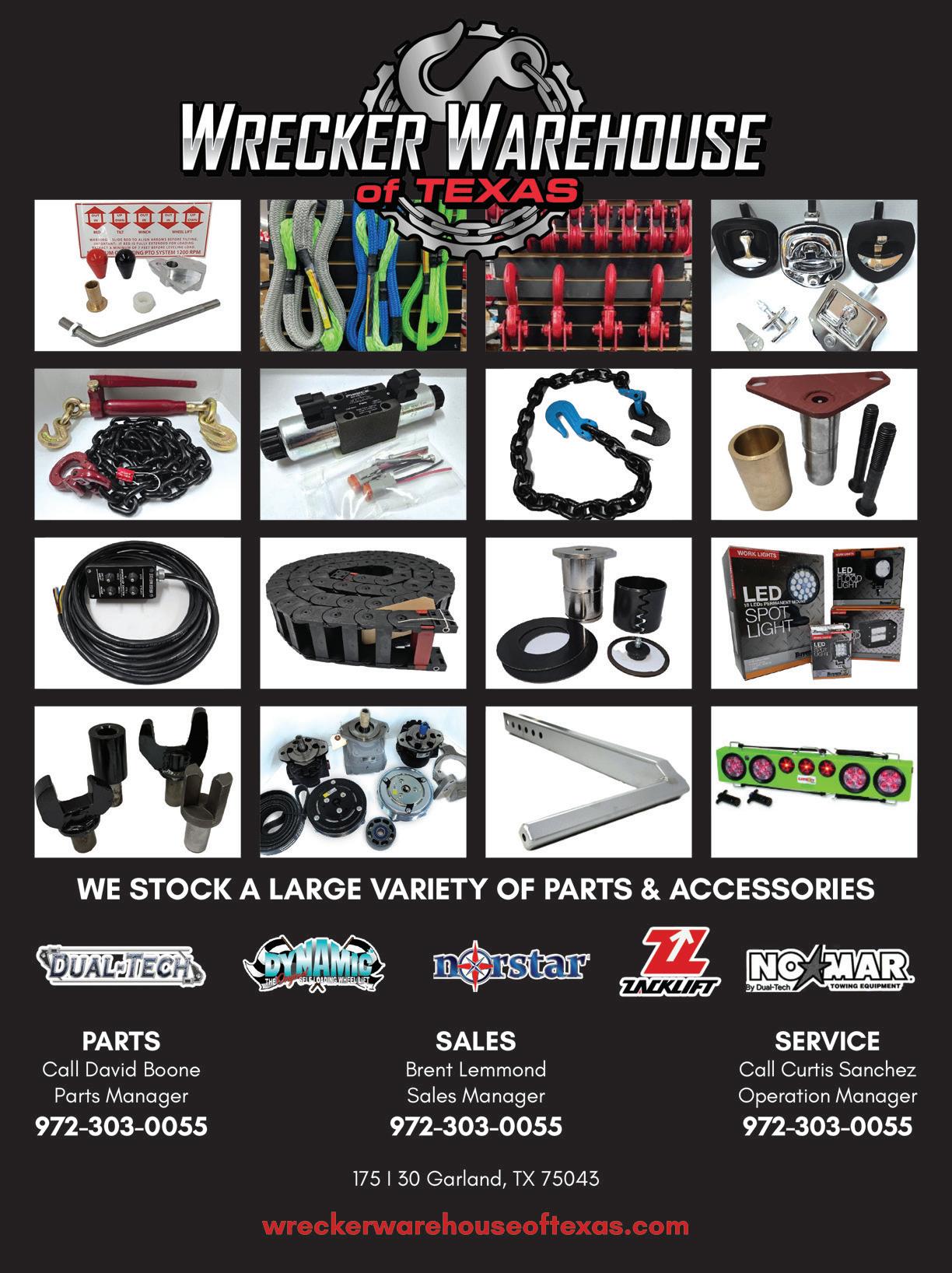
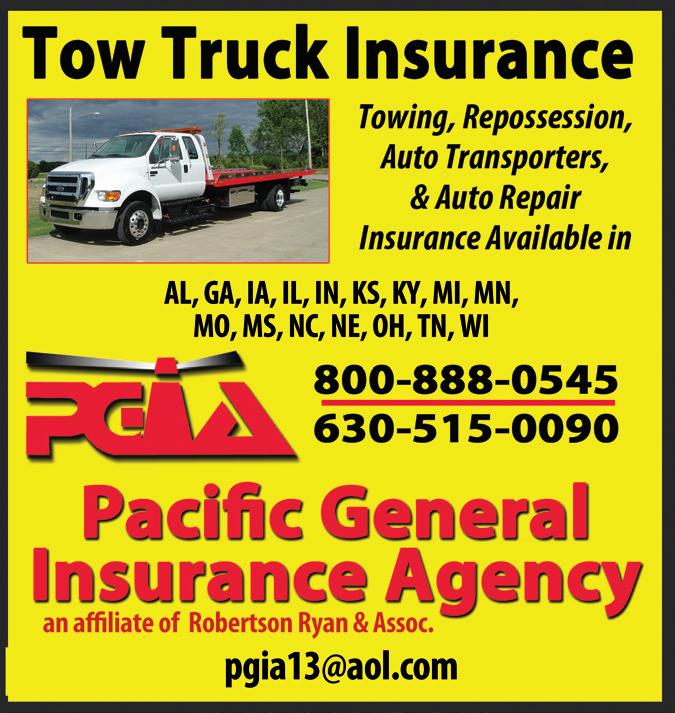
as Towman of the Year, will be heading up this special presentation. Tow business owners and managers dealing with the challenge of hiring and keeping good tow operators will certainly benefit from this informative program.
For details on attending, go to https:// americantowman.com/academy.
Fuel card skimming has become a growing concern for truck fleets, with scammers installing deceptive devices on truck stop fuel pumps to capture payment card information. Once obtained, fraudsters use the stolen data for unauthorized purchases until fleet managers intervene. However, the trucking industry has made significant progress in addressing this issue.
Industry leaders highlight the shift toward digital payment systems as a major defense against fuel card skimming. According to Spencer Barkoff, president of Relay Payments, the transition




to cardless payments has significantly reduced the occurrence of skimming. Digital solutions eliminate the need for physical cards, removing the primary target for scammers.
Teaming up with telematics technology, fleets can now track high-risk areas where skimming has been prevalent. Erika Voss, vice president of DAT Freight & Analytics, recommends drivers avoid sketchy locations and inspect card readers for signs of tampering. She also emphasizes covering the keypad when entering security codes.
As skimming declines, scammers are turning to more advanced tactics, using AI to deceive individuals into revealing login credentials and multi-factor codes. Experts stress the importance of educating employees to recognize and reject these scams. Fraud detection software is also playing a key role in safeguarding against these increasingly sophisticated threats.
Source: ttnews.com

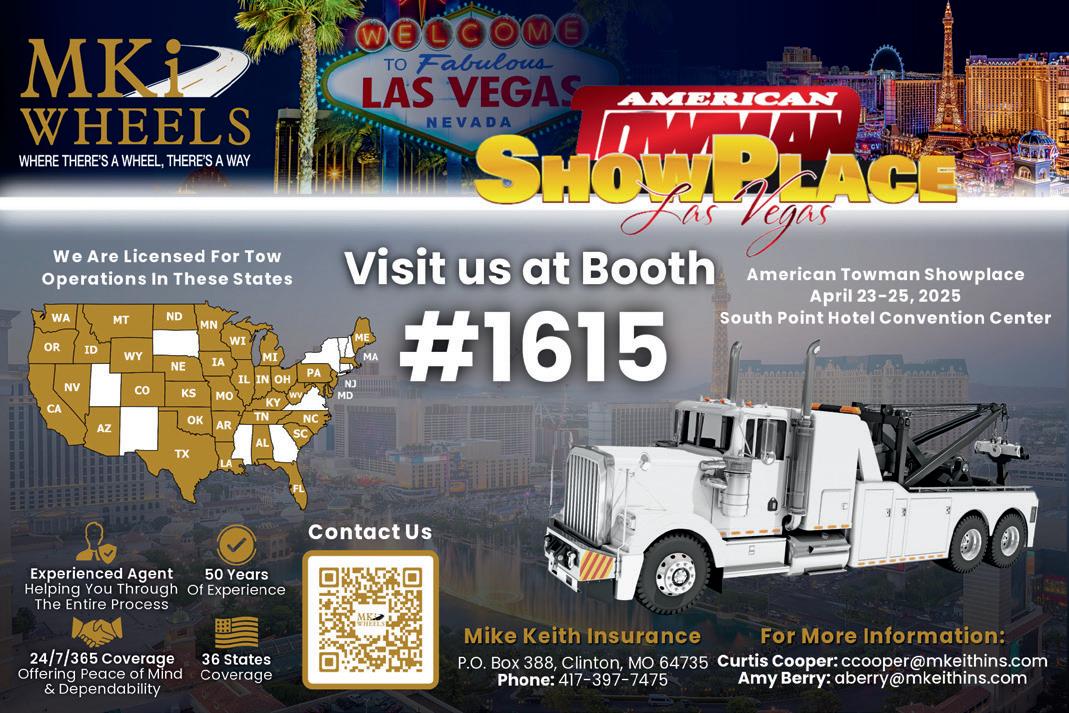

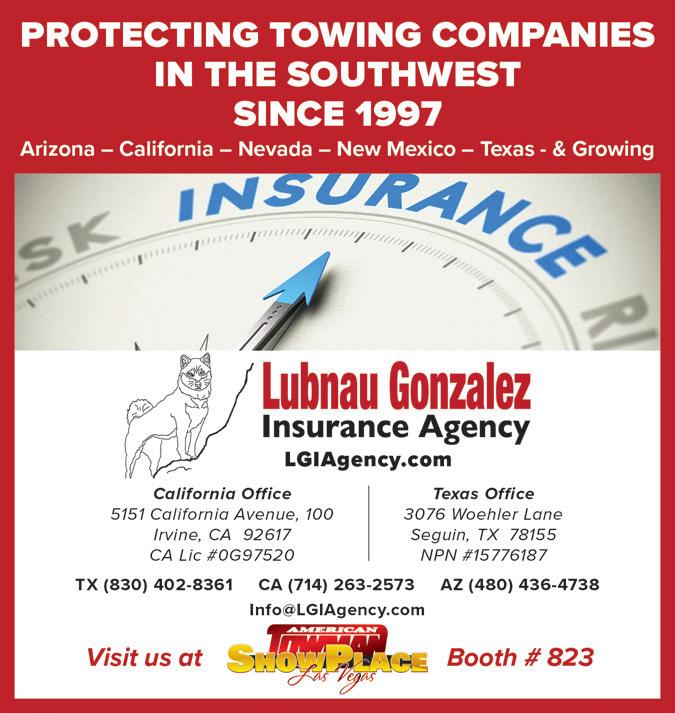
The Federal Motor Carrier Safety Administration (FMCSA) has appointed Adrienne Camire as its acting administrator. Camire, a veteran of the Trump administration, previously served as chief counsel for the Federal Highway Administration (FHWA), where she managed legal services for federal aid highway programs. With over 20 years of experience in legal, regulatory, and compliance roles, Camire brings significant expertise to the position.
In her new role, Camire will lead efforts to enhance commercial motor vehicle safety and improve the efficiency of the nation’s transportation systems. Transportation Secretary Sean Duffy praised her leadership, emphasizing her commitment to safety and her ability to make America’s roads safer. Camire expressed gratitude for the opportunity, stating, “I’m honored to lead FMCSA in its mission to prevent commercial motor vehicle crashes and injuries.”
Source: ttnews.com
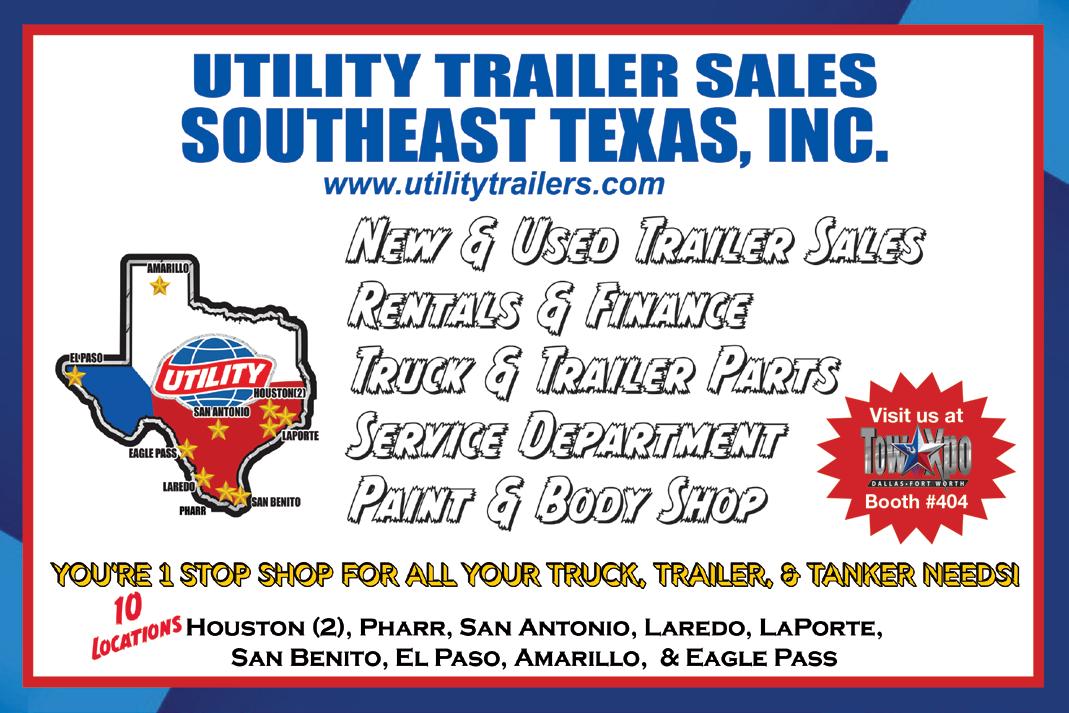
by Don Lomax
